- [email protected]
- (650) 338-8226

Cupertino, CA

- Our Philosophy
- Our Results
- News, Media, and Press
- Common Application
- College Application Essay Editing
- Extracurricular Planning
- Academic Guidance
- Summer Programs
- Interview Preparation
Middle School
- Pre-High School Consultation
- Boarding School Admissions
College Admissions
- Academic and Extracurricular Profile Evaluation
- Senior Editor College Application Program
- Summer Program Applications
- Private Consulting Program
- Transfer Admissions
- UC Transfer Admissions
- Ivy League Transfer Admissions
Graduate Admissions
- Graduate School Admissions
- MBA Admissions
Private Tutoring
- SAT/ACT Tutoring
- AP Exam Tutoring
- Olympiad Training
Research Programs
- Science Research Program
- Humanities Competitions
- Passion Project Program
- Ad Hoc Consulting
- Athletic Recruitment
- National Universities Rankings
- Liberal Arts Colleges Rankings
- Public Schools Rankings
Acceptance Rates
- University Acceptance Rates
- Transfer Acceptance Rates
- Supplemental Essays
- College Admissions Data
- Chances Calculator
- GPA Calculator
National Universities
- College Acceptance Rates
- College Overall Acceptance Rates
- College Regular Acceptance Rates
- College Early Acceptance Rates
- Ivy League Acceptance Rates
- Ivy League Overall Acceptance Rates
- Ivy League Regular Acceptance Rates
- Ivy League Early Acceptance Rates
Public Schools
- Public Schools Acceptance Rates
- Public Schools Overall Acceptance Rates
- Public Schools Regular Acceptance Rates
- Public Schools Early Acceptance Rates
Liberal Arts
- Liberal Arts Colleges Acceptance Rates
- Liberal Arts Colleges Overall Acceptance Rates
- Liberal Arts Colleges Regular Acceptance Rates
- Liberal Arts Colleges Early Acceptance Rates

Third-Person Writing: A Guide for Effective Academic Writing

By Eric Eng

In this post, we will explore the concept of third-person writing and its importance for academic writing. We will discuss the benefits of using third-person language, provide examples of how it can be used in different types of academic writing, and offer practical tips for incorporating it into your writing. By the end of this post, you will have a solid understanding of third-person writing and how to use it effectively in your academic work.
Academic writing is a fundamental part of any high school student’s education, and mastering the art of writing in a clear and concise manner is essential to academic success. One key aspect of effective academic writing is the use of third-person language, which can help writers create a more objective and authoritative tone.
What is third-person writing?
What is third-person writing? Third-person writing is a style of writing that involves using pronouns such as “he,” “she,” “it,” “they,” or “one” to refer to individuals or objects instead of using first- or second-person pronouns like “I,” “me,” “we,” “us,” “you,” or “your.” Third-person language is commonly used in academic writing to create a more objective and authoritative tone.
For instance, instead of saying “I believe,” third-person writing would say, “It can be argued.” This writing style can be particularly effective when presenting research or making a persuasive argument, as it allows the writer to distance themselves from their ideas and present them as more balanced and objective.
Writing in the third person differs from first- and second-person writing in several key ways. First-person writing involves using pronouns like “I,” “me,” “we,” or “us” to refer to oneself or a group of individuals. This writing style is often used in personal narratives, memoirs, or opinion pieces, where the writer’s personal experiences or opinions are central to the piece.
Conversely, second-person writing involves using pronouns like “you” or “your” to address the reader directly.

This writing style is often used in instructional or self-help texts, where the writer gives advice or instructions to the reader. In contrast, writing in the third person avoids direct references to the writer or reader and instead focuses on the topic or subject. This writing style can be particularly effective in academic writing , where objectivity and a neutral tone are often valued.
The benefits of using third-person writing in academic writing
Using the third-person point of view in academic writing offers several benefits, including creating a more objective and authoritative tone. By using third-person pronouns instead of first-person pronouns, writers can present information more neutral and unbiased. This can be particularly important in academic writing, where presenting a balanced and objective perspective is often valued.
Writing in the third person can also help writers distance themselves from their arguments and present a more balanced perspective. By using third-person pronouns, writers can avoid appearing overly confident or biased. Instead, they can present their arguments in a more measured and thoughtful way, allowing readers to make their judgments about the validity of the arguments presented.
Moreover, it can be especially useful in academic writing that involves research. When presenting research findings or making a persuasive argument, writers may be tempted to rely heavily on first-person language to convince readers of the validity of their claims. However, this can undermine the persuasiveness of the argument.
Using third-person writing instead can help writers present their research findings and arguments in a more objective and authoritative way, ultimately making their work more convincing to readers.
In summary, using a third-person point of view in academic writing can help writers create a more objective and authoritative tone, distance themselves from their arguments, and present a more balanced perspective. By using third-person pronouns and language effectively, writers can make their writing more persuasive and ultimately more successful in communicating their ideas to their readers.
What are the words to avoid in third-person writing?
What are the words to avoid in third-person writing? When writing in the third person, it’s important to avoid using first- and second-person language, as these types can make the writing appear less objective and authoritative. Here are some examples of words and phrases to avoid when writing in the third person:
- First-person pronouns: This includes words like “I,” “me,” “my,” “we,” and “us.” Avoid using these pronouns in the third-person point of view.
- Second-person pronouns include words like “you” and “your.” Avoid using these pronouns, as they can make the writing feel more direct and less objective.
- Imperative verbs: Imperative verbs are those that give commands or instructions, such as “do,” “make,” or “take.” These verbs should generally be avoided as they can make the writing feel less objective and more directive.
- Personal opinions: It’s important to avoid including personal opinions or biases. Instead, focus on presenting the facts and allowing readers to draw their conclusions.
By avoiding these words and phrases, writers can create more effective and authoritative third-person writing better suited for academic and professional contexts.
Examples of third-person writing in academic writing
The third-person point of view is commonly used in various academic writing contexts, including research papers, literature reviews, and essays . Here are some examples of how third-person writing can be used effectively in these contexts:

- Research papers: In research papers, it can be used to present research findings and conclusions in a more objective and authoritative manner. For example, instead of saying, “I found that,” a third-person point of view would say, “It was found that.” This helps to create a more neutral tone and emphasizes the importance of the research itself rather than the researcher’s personal experience.
- Literature reviews: In literature reviews , it can be used to summarize and analyze existing research in an objective and authoritative way. For example, instead of saying, “I think that this study is important,” third-person writing would say, “This study has been found to be important by previous researchers.” This helps to emphasize the research’s importance and present it more objectively and neutrally.
- Essays: In essays, it can be used to present arguments and evidence in a more balanced and persuasive manner. For example, instead of saying, “I believe that,” a third-person point of view would say, “It can be argued that.” This helps to present the argument in a more objective and authoritative way, which can be particularly important in persuasive essays.
The potential benefits of using third-person writing in each of these contexts include the following:
- Creating a more objective and authoritative tone.
- Emphasizing the importance of the research or argument rather than the writer’s personal experience or opinion.
- Presenting information in a more balanced and neutral way.
By writing in the third person effectively, writers can make their academic writing more effective and persuasive, ultimately helping to communicate their ideas more effectively to their readers.
Tips for using third-person writing in academic writing
To effectively incorporate third-person writing into academic writing, consider the following tips:
- Use active voice: Using active voice can help to make the third-person point of view more engaging and direct. For example, instead of saying, “It was found that,” say, “Researchers found that.” This can make the writing feel engaging rather than passive and dull.
- Vary sentence structure: To avoid overusing third-person pronouns, try to vary sentence structure. For example, instead of repeatedly using “he” or “she,” try using more descriptive phrases or words, such as “the researcher” or “the author.”
- Avoid personal opinions: In third-person writing, it’s important to avoid personal opinions or biases. Instead, focus on presenting the facts and allowing readers to draw their own conclusions.
- Use reliable sources: In academic writing, it’s important to use reliable and trustworthy sources to support your arguments. Make sure to cite your sources properly and avoid using biased or unreliable sources.
- Proofread carefully: Finally, proofread your writing carefully to ensure you’ve used third-person language consistently and effectively. Look for instances of first- or second-person language and replace them with third-person language, as necessary.
Common mistakes to avoid when using third-person writing in academic writing include overusing third-person pronouns, failing to vary sentence structure, and using vague or ambiguous language. Additionally, it’s important to avoid using personal opinions or biases, as this can undermine the objectivity and authority of your writing.

By following these tips and avoiding common mistakes, you can effectively incorporate third-person pov into your academic writing and create more persuasive and authoritative pieces.
In conclusion, using third-person writing can be a powerful tool for high school students looking to improve their academic writing. Students can create a more objective, authoritative, and balanced tone in their writing by avoiding first- and second-person language and using third-person pronouns and another language.
The benefits of using third-person writing include presenting research findings and arguments in a more neutral and objective manner, emphasizing the importance of the research or argument rather than the writer’s personal experience or opinion, and presenting information in a more balanced and neutral way.
By incorporating these tips and avoiding common mistakes, students can make their academic writing more effective and persuasive.
Having all the necessary information is important before choosing any course of action. AdmissionSight is always here to assist you with any questions or concerns. We have more than ten years of expertise assisting students in successfully navigating the challenging admissions process.
Consult with AdmissionSight and find out what we can do to help you get into the school of your choice by ensuring that you are sufficiently aware and well-prepared for the application process.
Want to assess your chances of admission? Take our FREE chances calculator today!

Why College Admissions Isn’t Perfect

US News Rankings

The Personal Statement: The Holy Grail of College Admissions

The Modern Day 4.0 and 1600 SAT Score Student Is No Longer Impressive

The Competitive Nature of College Admissions for Asian Americans

The College Application

Our Comprehensive Approach

Ivy League Schools

How Early Should You Prepare for College?

Featured in US News & World Report Best Colleges Publication

Congratulations to AdmissionSight Students and their Acceptances!

College Rejection

College Rankings

College Consultants Could Make A Difference

College Admissions Scandal and Higher Education

The 7 Best Colleges for Figure Skating

Understanding Restrictive Early Action at Harvard

How to Get into Harvard: Admission Requirements and Tips

Carnegie Mellon University: Weighing the Pros and Cons

The Best Colleges for Pre-Med

Top 5 Princeton Majors: A Quick Guide

How Many People Apply to Stanford: Impact of Legacy Preferences on Admission

Top 10 Unique Classes at Brown University

Yale’s Hidden World: How Many Secret Societies Exist?

Discover the Best Law Schools in the US This 2024

Is Georgetown University a Good School? Insights and Tips
Fun facts about princeton university: discover why it’s one of america’s top universities.

What Is the Best Ivy League School For You? A Quick Guide

UCLA Scholarships: All You Need to Know

Pros and Cons of Harvard University: All You Need to Know

How Hard Is It to Get into the University of Chicago?

A Quick Guide to the Different Colleges and Universities in the U.S.
Leave a comment cancel reply.
Your email address will not be published. Required fields are marked *
Save my name, email, and website in this browser for the next time I comment.
Recent Articles

The 7 Best Colleges for...

Understanding Restrictive Early Action at...

How to Get into Harvard:...

Carnegie Mellon University: Weighing the...

Top 5 Princeton Majors: A...

How Many People Apply to...

Top 10 Unique Classes at...

Yale's Hidden World: How Many...

Discover the Best Law Schools...

Is Georgetown University a Good...

Fun Facts about Princeton University:...
Sign up now to receive insights on how to navigate the college admissions process..

Admissions Counseling
- Academic & Extracurricular Profile Evaluation
Copyright © AdmissionSight 2024
Privacy Policy - Terms and Conditions
Writing in Third Person – Examples
| Candace Osmond
Candace Osmond
Candace Osmond studied Advanced Writing & Editing Essentials at MHC. She’s been an International and USA TODAY Bestselling Author for over a decade. And she’s worked as an Editor for several mid-sized publications. Candace has a keen eye for content editing and a high degree of expertise in Fiction.
The third-person narrative is often employed in narrative writing because it zooms in and out of character perspectives to describe actions, feelings, emotions, and thoughts. If you’re unsure how to use the 3rd person perspective in writing, here are some tips and examples.
What is Third Person Narrative?

The third person is one of three perspectives employed in speaking and writing. It’s used to describe the point of view of a third party and uses a variety of pronouns derived from he, her, and it. Books written in third person are often more popular, as well, for their ease of reading.
I often write in first-person narrative, but when I’m writing a complex story from the point of view of multiple characters, I use third person to make things more rounded and streamlined for the reader.
Using Third Person
Third person is a perspective used based on whoever the story or writing in question is about. The subject pronoun is outside of the narrator themself. Third-person texts do not include the perspective of the narrator/writer, nor does it address the reader directly. It also uses certain personal pronouns and possessive pronouns.
Example of a third person sentence:
Jeremy knew it was destined to be. He placed the dog in the backseat of his car and drove away. All he wanted at that time was to ensure the animal got the loving home he deserved.
Third Person Possessive Adjectives in Third Person
So, instead of using me, mine, ours, etc., you would use hers, his, theirs when writing in third person.
Does “You” Belong in 3rd Person Writing?
Third-person writing requires using third-person pronouns, including he, she, it, him, her, them, themselves, himself, herself, or a name. Using “you” means you’re switching to the second person.
How to Introduce Yourself in the Third Person
People typically use the first-person point of view when talking about themselves and their experiences. It would be odd to talk about oneself in the third person all the time, but you might use it occasionally for the sake of humorous effect or attract the attention of another person.
The third person introduces a third party to the person you’re speaking with. If you are a narrator, it’s best to introduce yourself in the first person and start narrating the events in the third person.
How to Start a Story in Third Person
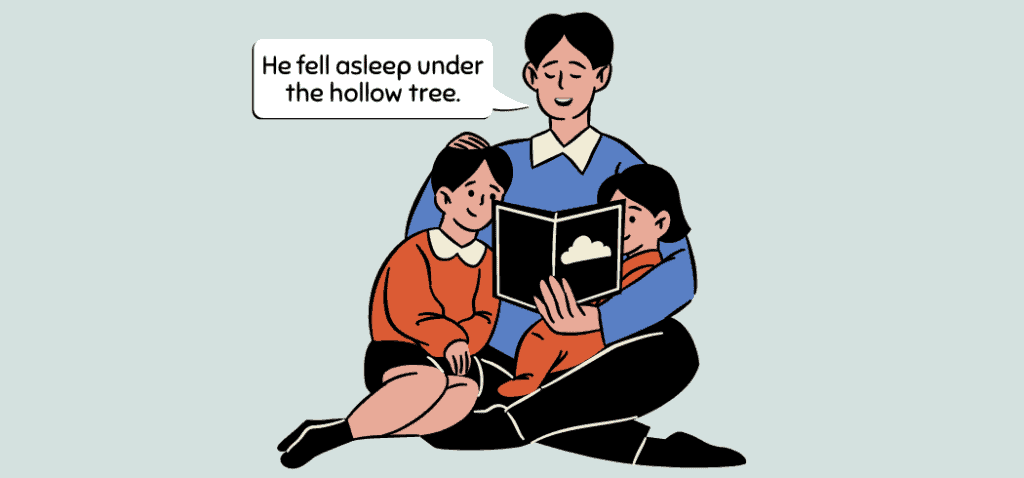
In a story, narrators use the third person if they are not part of the story themselves. Third-person narratives show us a person’s actions, feelings, and thoughts.
Example of how to write in third person:
Nadia dreamt about being a gymnast her entire life. Ever since she can remember, she’s worked hard, sacrificed a lot, and hoped someone would notice all her efforts. She was never the smartest kid in school, but she believed in herself enough to never give up on that spot on the podium.
What Are the 3 Types of 3rd Person?
In writing, there are three ways to approach third-person writing.
Third-Person Omniscient
The story’s narrator is all-knowing and can see into the past, present, and future. This narrator can assume other people’s perspectives, jumping around in time and providing the reader with their thoughts and observations.
Third-Person Limited Omniscient
In this point of view, the author focuses on one persona and never switches to another. In a novel, the narrator may use this technique throughout the work or employ it in alternating chapters or sections.
The author can regulate the reader’s knowledge and experience by writing from a limited point of view. Used effectively, it can create a palpable sense of anticipation and excitement.
Third-Person Objective
The narrator of a story told from the third-person objective perspective is unbiased and does not share the viewpoint of the character’s emotional reactions. The story is told in an objective, third-person style.
How to Write In Third Person About Yourself
The easiest way to approach this problem is to create a character. You can also use your actual name to write from the third-person perspective.
Why Write in Third-Person?
Fiction writing uses third-person POV quite often. Here are some advantages of employing it as part of your narrative style.
Strong Character Growth Is Emphasized
More characters can be highlighted in a story told from the third-person perspective than in the first- or second-person. These varying perspectives give the reader a complete understanding of the story since they shed light on the plot in ways the other characters cannot.
It Employs Flexible Narrative Possibilities
The advantages of writing in the third person include greater freedom to move around, giving the reader a comprehensive view, and shifting perspectives among multiple characters. You can switch between being completely all-knowing and having only partial or first-person knowledge.
This latter technique allows the reader to experience the world through the eyes of a character, allowing for a more profound understanding of that person and their surroundings.
Makes the Author More Reliable
Third-person narration places the reader in a vantage point far above the action. With the author/narrator not part of the story, they can rise above it, having nothing to lose or gain from certain narrative developments. This makes the story more reliable and lends the story more authority and credibility.
First, Second, and Third Person Pronouns
If you’re confused about the types of pronouns used in each of the three main perspectives, here is a comprehensive list:
- First person pronouns: I, me, mine, myself, we, us, ourselves, ours.
- Second person pronouns: you, your, yours.
- Third person singular pronouns: he, him, his, she, her, it,
- Third person plural pronouns: its, itself, they, them, their, theirs, themselves.
Bottom Line on Third Person
Writing in 3rd person grants the author more credibility and offers a more objective perspective of the characters in the text. Often employed in fictional and academic writing, the third-person point of view makes the text seem more authentic and factually correct.
Grammarist is a participant in the Amazon Services LLC Associates Program, an affiliate advertising program designed to provide a means for sites to earn advertising fees by advertising and linking to Amazon.com. When you buy via the links on our site, we may earn an affiliate commission at no cost to you.
2024 © Grammarist, a Found First Marketing company. All rights reserved.
How to Write in Third Person Point of View: 12 Tips for Writing in Third-Person Point of View
- August 21, 2024
- Freelancing Tips
Table of Contents Hide
First-person, second-person, third-person, when to write in third-person point of view, third-person omniscient point of view:, third-person limited point of view:, third-person objective point of view:, how to use the third-person point of view, strong character development., narrative flexibility, an authoritative, trustworthy narrator, 1.choose the best type of third-person pov for your story, 2.use third-person pronouns, 3.understand your voice won’t always shine in your essays, 4.don’t focus on yourself or the reader — focus on the text, 5.coach yourself out of using first-person pronouns, 6.be as specific as possible, 7.write in the present tense when using third-person, 8.avoid adding your own thoughts, 9.in third-person objective, stay out of everyone’s heads., frequently asked questions about writing in third-person, we also recommend.
If your writing is for academic purposes, use third person point of view. Third person is pretty easy to master with a little practice.
If you’re new to it, we have a guide that will guide you in every step of the way
What does writing in the third person mean?
The third person point of view is one of three writing styles that can be used to explain a point of view. Even if you don’t realize it, you’ve most certainly used first, second, and third person in writing projects throughout your education.
It is a narrative in which you compose and examine the subject matter entirely on your initiative. You remain impartial. You do not attempt to change readers’ opinions. It’s a completely impartial, objective writing style that gets right to the heart of a subject or tells a story.
If you need to know how to differentiate between them three. Here’s a quick breakdown to understand the differences when you write your next paper:
See also: 10 Types of Creative Nonfiction Books and Genres and How to Write It
This is from the I/we perspective. This is where we talk about our beliefs, ourselves, and ourselves. When writing in the first person, you will use pronouns like I, me, myself, and mine.
This point of view belongs to the person you’re addressing; therefore, it is a ‘you’ perspective. You would use second-person pronouns in your work, such as you, your, and yourself.
The writing style used in stories is known as the third person point of view, and it is aimed at the person or people under discussion. In this perspective, the pronouns he, she, him, her, his, hers, himself, herself, it, them, their, and themselves are used. You may also use a name. But that tends to happen more in stories than research papers.
Can you now differentiate them?
The third-person point of view is quite common in academic writing since it tells the reader a story and is frequently used when taking an authoritative attitude in your work.
As a result, while writing academic materials such as essays and research papers, always use the third person.
The reason for this is that it will make your work less biased and more objective, thereby increasing your reputation. The third-person perspective allows you to focus on the facts and data rather than your personal opinion, which will eventually boost your grades.
You can break third-person perspectives into three other types, including omniscient, limited, and objective. Although they’re more associated with creative writing than academic work and essays, your writing is likely to fall under the third-person objective point of view.
See also: How to Write and Publish Your Poetry Book
The 3 Types of Third-Person Point of View
The omniscient narrator understands the plot and the characters. This narrator can travel freely across time, enter the minds of any character, and share with the reader both their own and the character’s thoughts and observations.
For example, Jane Austen’s Pride and Prejudice uses a third-person omniscient point of view, giving the reader complete access to the primary character, Elizabeth, and everyone around her.
Also known as a “close third,” this limited point of view happens when an author writes in the third person while focusing on a single character. The narrator can switch between characters in each chapter or portion of the book, or they can do so throughout.
With this point of view, the author can limit the reader’s perspective and control the information they are aware of. It is used to heighten tension and arouse curiosity.
In this type of narration, the narrator is objective and oblivious to any character’s emotions or ideas. The narrator tells the story with an observant approach.
Ernest Hemingway uses this third-person narrative voice in his short story “Hills Like White Elephants.” An unidentified narrator tells the story of a couple in Spain talking while waiting for a train. With this point of view, the reader becomes a voyeur, listening in on a scene or story.
See also: Do You Italicize Book Titles? Essay Secrets Revealed
Rule number one: never refer to yourself in the third person in an article. That’s not acceptable.
For example, if your essay is about virtual learning, here’s what not to include in the sentence.
“I feel like students perform better at home because they have more freedom and are more comfortable.”
It’s a simple sentence, but when addressing research papers and using a third-person narrative, there are various concerns. Why? You are making comments that sound like opinions because you are using first-person pronouns, and you are unable to back them up with facts or credible research.
Also, it isn’t very assertive. “I feel like” will not impress the person evaluating your work because it lacks authority and underlines that it originated just in your mind and is insignificant in any way.
However, if you alter the example to the third-person perspective, you can reference your sources, which is exactly what you should do to improve your essay and research paper marks.
Let’s rewrite the line in a more expansive third person point of view:
“A psychological study from Karrie Goodwin shows that students thrive in virtual classrooms as they offer flexibility. They can make their hours and take regular breaks. Another study from high school teacher, Ashlee Trip, highlighted that children enjoy freedom, the ability to work at their own pace and decide what their day will look like.”
With a third-person narrative, you can present evidence to the reader and back up the claims you make. As a result, it not only shows your knowledge but also your diligence in researching and backing up your work with credible sources and facts rather than simply your opinions.
Advantages and Reasons to Write in Third Person Point of View
When compared to the first and second person, the third person can highlight more characters and cover a longer narrative arc.
A reader can see the story from every perspective, and each one contributes elements that a character lacks in the other, resulting in a rich, complex narrative.
The third person allows for greater adaptability; you can help your reader see everything, be everywhere, and switch between different characters’ stories. You can go from complete omniscience to a limited or close third point of view.
This latter strategy allows readers to have a greater understanding of a character and scenario by entering the characters’ thoughts, feelings, and experiences.
See also: How to Write a Book With No Experience for Beginners in 12 Steps
Writing from the third person point of view places the narrator above the action, creating a bird’s-eye-view of the story.
Because the narrator has nothing at stake, this perspective, combined with knowledge of at least one character’s thoughts in both omniscient and limited third person, lends the story a more authoritative, trustworthy tone.
Tips for Writing in Third 3 rd person
Before you begin writing your story, think about whether a third person perspective—limited, omniscient, or objective—will work best for it. Each has an advantage when it comes to narrative. Do you want the reader to remain in suspense and only learn what the main character discovers?
Next, write your story in a limited third person. Consider writing an epic narrative in the third person omniscient viewpoint, allowing your narrator to be all-knowing and featuring a big cast of people.
When using third-person pronouns such as “he,” “she,” “it,” or “they” instead of referring to specific characters by name, make sure to be consistent.
Every written work has a voice or point of view that appears to be directed specifically at the reader. This is not always possible, however, because academic writing is more objective than, example, a book.
Your academic work does not require you to “fluff” up your writing to inject your personality into it.
The purpose of academic writing is to consistently maintain a formal tone. Your next paper should be written to write in mind, rather than the writer or reader.
If you’ve only ever written in the first or second person, this is easier said than done. If you find yourself writing in the first person when writing your next paper, go back and alter it to a third-person perspective.
This is the point at which things become a little unclear. The key to writing in the third person is to use pronouns like they, it, he, or she. However, using them at the beginning of sentences can appear confusing and potentially mislead the reader, which is the last thing you want in your paper or essay.
Instead, consider using nouns at the beginning of sentences as an alternative. For example, when beginning a statement, use the actual subject—the writer or the interviewer—rather than he, she, or they.
See also: 15 Best Personal Finance Books for Freelance Writers
All academic writing, including reports, essays, and research papers, must be written in the present tense, especially when introducing new themes or discoveries.
As a result, you should write “This report analyzes” as if you are analyzing right now, rather than “This paper analyzed,” which appears to be correct because it occurred in the past and the writing is in the present.
The difference is that you should use the past tense when describing your research approach. This implies, for example, that you would use the third person to refer to “the equipment that was used” or “the results were analyzed by.”
If the topic of your report is something you are deeply interested in, it can be very tempting to include some of your own thoughts. Although you must coach yourself out of it.
In academic writing, you aren’t a commentator. You’re a reporter. It is important to let readers draw their conclusions without over-analyzing them or making the reader lean one way or another.
If you want to write from an objective point of view, see your characters as complete outsiders, keep in mind that your narrator is blind to their thoughts. As an outside observer, you can only tell the reader what you observe.
Write in a detailed style to convey emotions. Describing a character’s eyes and facial emotions can help to emphasize character growth, conflict, and plot development.
The third person uses pronouns such he, she, him, her, his, hers, himself, herself, it, them, their, and themselves. You may also use a name.
You is used in second person and is therefore not used in third person. The second person is used for the person that is being addressed.
The third-person point of view is aimed at the person or people being talked about, which is the type of writing you’d find in stories. When writing in third-person view, make sure to write in the present tense and avoid adding your own thoughts.
Writing in the third person in academic papers is easy to learn if you practice regularly and consistently. Examine and critique your work until it is regarded as the norm. Sure, it may be confusing at first, but you’ll rapidly learn the technique and be able to improve your papers and reports.
Keep in mind that the third-person narrator only knows what the character knows. Be aware of your characters’ limitations. Review your writing frequently to ensure that you haven’t given your characters information they shouldn’t have.
- Bibguru – how to write in 3rd person
- Masterclass – how to write in third 3rd person
- How To Write an Application Letter to Chicken Republic for a Job in Nigeria
- How To Write an Application Letter to Join a Church Choir in Nigeria
- How To Write an Application Letter For Daycare Teacher With No Experience in Nigeria
- How To Write an Application Letter for Public Relations Officer with no Experience in Nigeria
Related Posts
How to write a letter of recommendation for a coworker: template, example, tips.
- September 12, 2024
How To Write An Address With An Apartment Number Perfectly Like a Pro to Avoid Mistakes
How to write a love letter to your boyfriend from start to finish: tips, examples, ideas.
TRY OUR FREE APP
Write your book in Reedsy Studio. Try the beloved writing app for free today.
Craft your masterpiece in Reedsy Studio
Plan, write, edit, and format your book in our free app made for authors.

Guides • Perfecting your Craft
Last updated on Nov 10, 2022
Third Person Point of View: The ‘He Said, She Said’ Narrative Style
About the author.
Reedsy's editorial team is a diverse group of industry experts devoted to helping authors write and publish beautiful books.
About Tom Bromley
Author, editor, tutor, and bestselling ghostwriter. Tom Bromley is the head of learning at Reedsy, where he has created their acclaimed course, 'How to Write a Novel.'
About Dario Villirilli
Editor-in-Chief of the Reedsy blog, Dario is a graduate of Mälardalen University. As a freelance writer, he has written for many esteemed outlets aimed at writers. A traveler at heart, he can be found roaming the world and working from his laptop.
Third person point of view is narrative style in which the narrator refers to all characters using the pronouns he , she , or they . An example of a sentence written in third person would be:
She sat in the café waiting for her food to arrive. “What is taking so long?” she thought.
Writers can zero in on individual characters using the third person limited perspective , or zoom out and tell the story from an omniscient POV , where the narrator is an all-knowing figure. Your POV choice will depend on what kind of story you want to tell, as you’ll discover in the next two posts in this series!
Here, however, we’ll simply cover everything you need to know about third person as a whole, and why writers might choose to use it over first or second person perspectives.

FREE COURSE
Understanding Point of View
Learn to master different POVs and choose the best for your story.
Third person stories often have a wider scope
First and second person stories are great for their immediacy, placing the reader right in the action. However, can be restrictive if you want readers to see the bigger picture. Complex stories with a large primary cast often benefit from a narrator who can swiftly move between characters and locations instead of being tethered to your viewpoint character. An example would be George R.R. Martin’s Song of Ice and Fire series, an epic fantasy series sprawling in scope that features an entire chorus of POV characters.
With each chapter break, Martin shifts to a new viewpoint character (while staying in third person), allowing him to span vast gaps in the geography of his world and give insight into each character’s personality.
The morning had dawned clear and cold, with a crispness that hinted at the end of summer. They set forth at daybreak to see a man beheaded, twenty in all, and Bran rode among them, nervous with excitement. This was the first time he had been deemed old enough to go with his lord father and his brothers to see the king's justice fine. It was the ninth year of summer, and the seventh of Bran's life.
The man had been taken outside a small holdfast in the hills. Robb thought he was a wildling, his sword sworn to Mance Rayder, King-beyond-the-Wall. It made Bran's skill prickle to think of it.
A Game of Thrones , George R.R. Martin
Martin’s third person narrator has the flexibilty to play this scene through the eyes of a nervously excited seven-year-old while also revealing useful expositional details like the idea of a “King-beyond-the-Wall” and Westeros’s decade-long gaps between winters.
Of course, one could argue that it’s possible to write a sprawling novel written from multiple first-person perspectives. But having an enormous cast all narrating in first person can be confusing, and would put a lot of pressure on the writer to sustain multiple convincing character voices.
(Psst! For more help with characterization when dealing with a large chorus of characters, you can check out our free character profile resource below.)

FREE RESOURCE
Reedsy’s Character Profile Template
A story is only as strong as its characters. Fill this out to develop yours.
While third person narration can allow the reader a great deal of intimacy with viewpoint characters, there are added benefits to staying out of your protagonist’s head.
It’s great for intrigue and suspense
One challenge of writing in first person is knowing how to toe the line between what your narrator knows and what they should reveal. Third person adds a little more distance, making it easier to flesh out main characters or move the story along without divulging information you wish to reveal later on.
This lends itself particularly well to thriller and mystery novels, where some holding back certain bits of exposition is essential to heightening the suspense. It can also be useful when writing any kind of novel that wants to deploy backstory or character history at a time when it can have maximum impact.
On the other hand, the third person isn’t just great for characters keeping secrets from the reader. An all-knowing narrator can also be useful for creating dramatic irony, revealing details that the characters don’t know themselves . For example, in the final act of Shakespeare’s Romeo and Juliet, Romeo discovers Juliet’s body. Unwilling to live in a world without the girl he has loved (for all of five days), he downs a vial of poison.
Come, bitter conduct, come, unsavoury guide!
Thou desperate pilot, now at once run on
The dashing rocks thy sea-sick weary bark!
Here’s to my love. O true apothecary,
Thy drugs are quick. Thus with a kiss I die.
— Romeo and Juliet (Act V, Scene III), William Shakespeare
At this point, the audience knows that Juliet is not dead — but merely sedated in a ploy to escape her family. The gulf between what the audience or reader knows and what the character knows creates an almost unbearable tension, bringing the story to its climax as Juliet awakens to discover her beloved’s corpse beside her.

Of course, dramatic irony can also be deployed more light-heartedly — for example, in comedies of error where humor is driven by a character misinterpreting the world around them. And speaking of understanding the world…

GET ACCOUNTABILITY
Meet writing coaches on Reedsy
Industry insiders can help you hone your craft, finish your draft, and get published.
Third person can help you build up your world
A third person point of view can be a great choice when your story requires a certain amount of descriptive worldbuilding. Whilst first and second person narrators certainly talk about their environment, third person narratives can offer a more natural way to include worldbuilding exposition, especially when extended passages of description might be required.
A first person narrator probably might not take the time to intricately describe something they’ve seen a thousand times. If you live in a world where society is ruled by a giant brain from outer space, you probably wouldn’t pause your story to arbitrarily explain the backstory of ‘President Lobularr the Cruel.' But a third person narrator will have no limits to what they might want to zero in on at any point in the story.
Though an all-seeing narrator gives writers the freedom to reveal setting and backstory in any way they see fit, don’t forget that one of the effective ways to draw readers into a setting is by showing how a character experiences that world. For example, in this passage from The Vanishing Half , author Brit Bennett describes a humid Louisiana rainstorm from the perspective of her protagonist, Desiree.
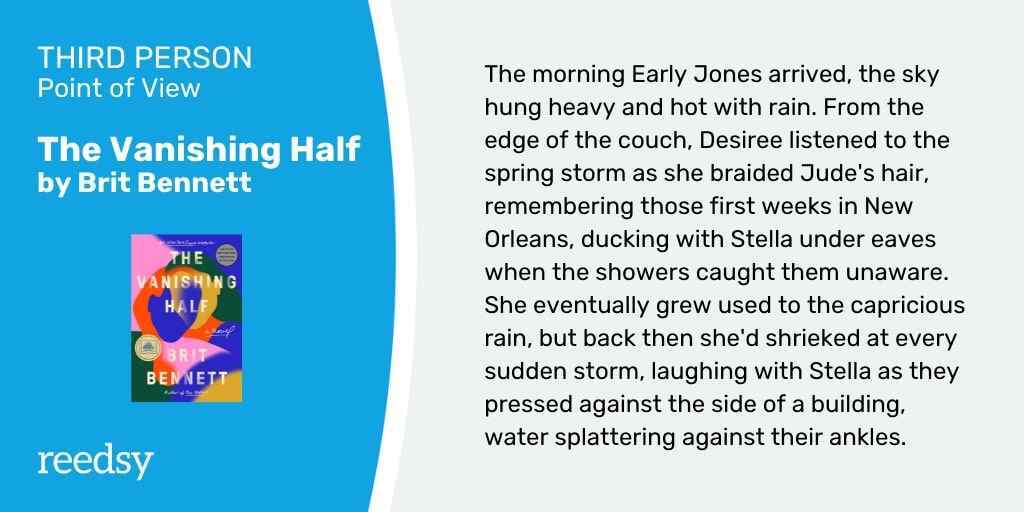
Instead of telling the reader that “it was a hot, rainy day,” this passage employs several “showing” devices, including strong verbs and sensory descriptions (“the sky hung heavy and hot,” “water splattering against their ankles”). Bennett evokes one of Desiree’s memories packed with specificity — the girls duck under “eaves” rather than just roofs, and the word “shrieked” conjures a very particular sound. The result practically drops the reader next to Desiree as she braids her daughter’s hair, half-lost in a ripple of nostalgia.
Written in third person, this passage is just as intimate and personal as it would have been were being narrated directly by Desiree, once again showing the versatility of this viewpoint.
Want to learn more about "show, don't tell"? You can check out our free 10-day course all about this golden rule of writing — it's useful for more than just third person narratives.

Show, Don't Tell
Master the golden rule of writing in 10 five-minute lessons.
It’s a viewpoint that doesn’t distract from the narrative
In its enduring popularity, third person narratives have become the default mode of storytelling around the world, pre-dating even thelikes of Homer (the epic poet, not the animated nuclear engineer). As a result of its long and impressive history, this viewpoint has thebenefit of instant familiarity.
Starting a story in third person helps readers settle in right away, rather than asking them to adjust to the particular voice of a first-person narrator or the unusual directness of second person . Ever found a story’s first chapter hard to settle into? This may be because of an unconventional narrative style or unanswered questions about who is doing the talking distracting you. Third person narratives are relatively easy to get into the swing of.
Which POV is right for your book?
Take our quiz to find out! Takes only 1 minute.
While many writers are keen to develop an utterly unique way of writing, most of the time, readers aren’t looking for something particularly experimental or opaque. In that way, the third person can be a writer’s best friend — a straightforward, versatile, and easily digestible narrative perspective that has stood the test of time.
And with that, we've concluded our post on third person point of view and how to write it! For more in-depth guidance on the two different styles of third person, limited and omniscient, be sure to check out the next couple of posts in this series.
In those posts, you’ll learn even more about which type of third person would best suit your own project, plus bonus tips on how to write in third person — to help you create a story that will be enjoyed by many more than three people, as it were.
Join a community of over 1 million authors
Reedsy is more than just a blog. Become a member today to discover how we can help you publish a beautiful book.
Bring your stories to life
Our free writing app lets you set writing goals and track your progress, so you can finally write that book!

1 million authors trust the professionals on Reedsy. Come meet them.
Enter your email or get started with a social account:

How to Write in the Third Person
You may have heard someone talking about third person POV in an English class or on a writers’ panel. What does it mean? POV stands for point of view, and any piece of prose writing has one. The point of view helps anchor the reader, and it makes the text easier to understand. Even in a story that doesn’t appear to come from a particular character’s voice, we can still assign the narration a point of view. When the point of view isn’t yours (second person) or mine (first person), then we call it third person narration. In this article, we’ll give you some tips to help you learn to write this way.
Your writing, at its best
Compose bold, clear, mistake-free, writing with Grammarly's AI-powered writing assistant
Avoid First Person
First person emphasizes the subjective point of view, and you can easily identify this writing style through the use of the pronouns “I” and “me”. Imagine an autobiography. The narrator explains his or her life by using phrases like this one: “I was born in a small town.” In a biography, written by another person, the text might read: “She was born in a small town.” That’s the difference between first person and third person. In first person, the narrator is the main character or, if not the main character, a character in the action. On the other hand, when a book is written in the third person, the story does not come from the point of view of a character. Instead, the writing describes things that happen to other people, characters besides the writer or the reader.
First person writing can be identified by the use of the following pronouns:

Avoid Second Person
Second person narration comes from the point of view of the reader. A second person point of view can often be found in the self-help or how-to genres, as well as in choice-based adventure books. “Choose Your Own Adventure® gamebooks began life in 1979 as the first publishing effort of a new division at Bantam Books focused on younger readers,” according to Chooseco LLC . Today, 265 million books have been published in this style. Let’s look at the summary of one of these books for a memorable example of second person narration:
“ You are a mountain climber, headed to the Himalayas to find proof that the mysterious yeti really exists. When your best friend Carlos goes missing from base camp, the fate of the expedition is in your hands.” — The Abominable Snowman
We added the bold font above to draw attention to some important pronouns. It’s easy to identify second person narration because it features second person pronouns:
What Is Third Person?
When a piece of writing does not assume the perspective of either the reader or the writer, it’s written in the third person point of view. Third person narratives have three distinct styles, known as third person objective, third person omniscient, and third person limited omniscient. You can recognize all three of these points of view through the use of third person pronouns, which include:
Third Person Objective
Imagine a history essay or a science article, written by a distant and neutral third party. The writer does not attempt to explain the perspective of any character; instead, he or she reports on the events with dispassion. If any opinions made their way into the text, they are properly attributed to the source.
Congressman Smith said, “X, Y, Z.” His constituent disagreed, arguing A.
The author of a third person objective article would never presume to speak for another person’s inner thoughts. Instead, the writer aims to present the facts and events in an orderly way, attributing the actions and dialogue to the proper characters.
This writing style is frequently used in academic writing and professional writing, but it can be used by fiction writers as well. As long as the author does not place thoughts inside the heads of characters, third person objective can work for any style of prose writing. If a writer wanted the reader to understand a character’s emotional state, he or she would have to make reference to body language, facial expression, and dialogue; otherwise, the character’s thoughts would remain opaque. The internal monologue of any character remains off limits from the objective point of view.
Third Person Omniscient
The third person omniscient point of view frequently appears in fiction writing. With this style, an all-knowing narrator has the ability to get inside any character’s head. That’s why an omniscient point of view can be thought of as “head-hopping.” The narrator has knowledge of everything. The characters have nowhere to hide—even their most intimate thoughts may be plumbed. Personal opinions and internal dialogue are all fair game, for any of the characters. In this style of writing, you can expect to see different points of view. As a reader, you can expect to know more about the different characters than the characters know about each other.
Third Person Limited Omniscient
Sometimes a writer engages a third person perspective, but they elevate one character above the rest. The writer may expound on that character’s thoughts, inner dialogue, and perspective. The focal character for the third person limited point of view is often called the viewpoint character. Typically, the viewpoint character is a main character in the story. The writer provides the reader with comprehensive access to this character’s thoughts, but all the other characters must be understood through actions, gestures, and dialogue. The reader must get by with limited information, since they rely on what the viewpoint character knows.
Still, the reader does not go “inside the head” of the viewpoint character completely. Rather than writing from the main character’s perspective in the first person point of view, the writer maintains a third person writing style. Without using first person pronouns, the author explores the thoughts of a single character. The narrator describes she and her, not I and me.
She worried that she would be late, but didn’t bother to tell her sister.
In the example above, the reader understands what the viewpoint character is thinking. On the other hand, the sister cannot read the viewpoint character’s thoughts. Likewise, the reader is not privy to the sister’s thoughts.
The omniscient limited and omniscient POV appear most commonly in creative writing. In general terms, third person objective or first person would be a more common choice for essays, articles, and nonfiction books.
Blending Perspectives
Now that you know the conventions for writing in first person, second person, third person objective, third person limited, and third person limited omniscient, you may want to revisit some of your favorite works of literature. Try to figure out their points of view, and think about why the author picked that perspective.
In your research, you may come across some books that defy categorization. Moby Dick by Herman Melville and Ulysses by James Joyce come to mind. Both books shift between third person and first person narration. Many fiction writers, especially modernist writers, flout convention by using a number of different narrative styles within the same work.
In creative writing, you should feel free to break the rules. Just be sure to understand the rules as you break them!
- https://examples.yourdictionary.com/examples-of-point-of-view.html
- https://www.britannica.com/art/novel/Narrative-method-and-point-of-view
- https://www.dictionary.com/e/1st-person-vs-2nd-person-vs-3rd-person-pov/
- https://www.merriam-webster.com/words-at-play/point-of-view-first-second-third-person-difference
- https://www.cyoa.com/

Kari Lisa Johnson
I’m an award-winning playwright with a penchant for wordplay. After earning a perfect score on the Writing SAT, I worked my way through Brown University by moonlighting as a Kaplan Test Prep tutor. I received a BA with honors in Literary Arts (Playwriting)—which gave me the opportunity to study under Pulitzer Prize-winner Paula Vogel. In my previous roles as new media producer with Rosetta Stone, director of marketing for global ventures with The Juilliard School, and vice president of digital strategy with Up & Coming Media, I helped develop the voice for international brands. From my home office in Maui, Hawaii, I currently work on freelance and ghostwriting projects.
Recent Posts

Dreams Meaning: Here’s What It Means and How To Use It

Chutzpah Meaning: Here’s What It Means and How To Use It

White Roses Meaning: Here’s What It Means and How To Use It

7777 Angel Number Meaning: Here’s What It Means and How to Use It?
- Grammar Checker
- Paraphrasing Tool
- Critique Report
- Writing Reports
- Learn Blog Grammar Guide Community Events FAQ
- Grammar Guide
What Is Third-Person Point of View and How Can You Use It in Your Writing?

By Walter Akolo
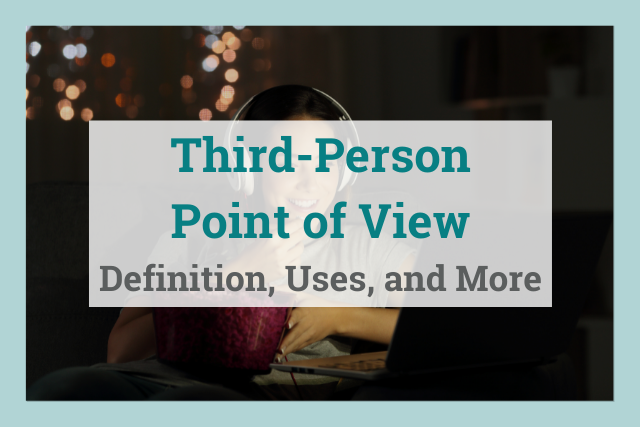
Have you ever read a book in which you felt like a bird sitting on the shoulder of the protagonist?
From the very first page, the author placed you in a position to see beyond what the character is seeing. So you can hear the door opening, or know when someone’s opening it, even if they don’t see it happening. It is books like this that are often so easy to consume—and that consume you, eventually.
And the technique that makes these books tick? Third-person point of view (POV).
If you’re looking to write a story that will grip your readers and put them on the edge of their seats, third-person perspective is your secret weapon. But what exactly is third-person point of view and how can you use it in your writing?
What Is Third-Person Point of View (POV)?
What are the different types of third-person pov, is it okay to mix perspectives, how do you write effectively in the third person, third-person pov examples, advantages of writing in third-person pov.
The third-person point of view is a common form of storytelling—a staple in works of fiction—in which the narrator uses third-person pronouns such as they , he , and she to best relate the action in the story.
Most new writers shun writing in the third-person perspective but, unknown to them, it affords a writer much more freedom in how they tell the story.
It’s the only perspective where the author can change the level of reader immersion in relation to the character.
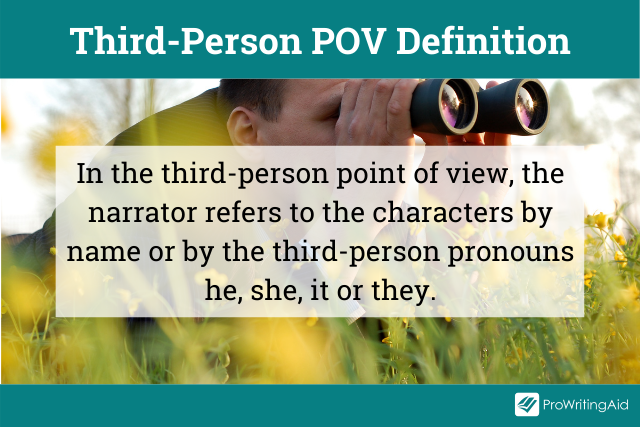
In the first-person perspective , the reader is focused on the point of view of the character—who they are, what they think and feel, and what they want to tell the reader. The author can add a more significant voice to the novel to flesh out the character and make them come alive.
In the second-person perspective , the reader is so deeply interacting with the story that they more or less become that character. It’s like you’re interacting with a character in a video game.
But the third-person perspective is less personal. Since the reader isn’t sitting in the character’s head or becoming the character, the author has the freedom to immerse the reader in the character however they desire—or even withhold knowledge of people and events to create tension and suspense.
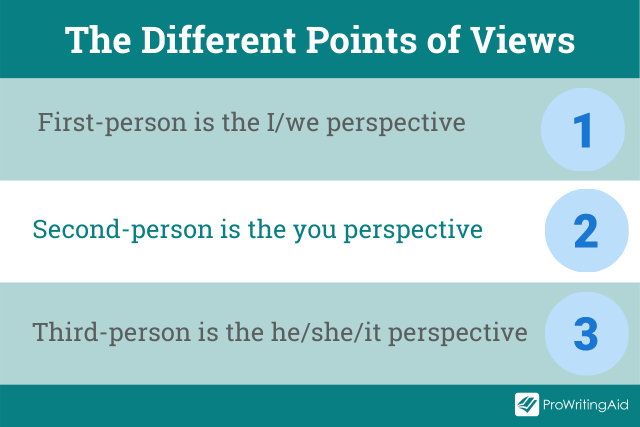
Immersing your readers in different levels of the third-person perspective adds pizazz to your story and grips your reader.
In Elements of Fiction Writing: Characters & Viewpoint , Orson Scott Card lists three types of third-person point of view:
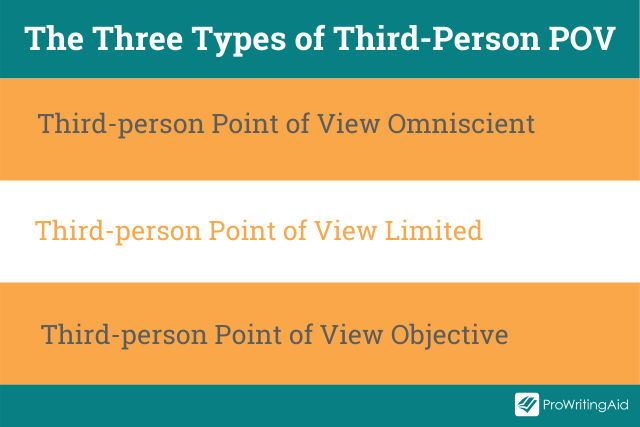
1. Third-Person Point of View Omniscient
Card explains that the omniscient third-person point of view gives the reader a line into the character’s eyes. Think of it as an insider’s view of every character’s thoughts, memories, dreams, longings, and deep-seated desires, as well as any point in time—whether present or future.
As a writer, third-person omniscient makes you the all-knowing narrator that relates and interprets events, thoughts, and feelings of all characters in the story. The novels Charlotte’s Web by E. B. White and Middlemarch by George Eliot use third-person omniscient POV.
2. Third-Person Point of View Limited
In the third-person limited POV, the narrator can access the thoughts and feelings of a single character in the story from the third-person perspective. The reader sees what the character is seeing but can only guess what is in another character’s mind.
But this viewpoint doesn’t prevent you from hopping into another character’s mind. Instead, it provides you with a clear division when switching characters (as in a new chapter break or an extra line space to help readers keep up with the story).
For example, if you’re writing inside John’s head and are switching to Ben’s POV, open the next section with Ben’s name, location, and point in time to keep the reader grounded in the story. It’s used to heighten suspense and build interest. The short story Miss Brill by Katherine Mansfield employs a third-person limited point of view.
3. Third-Person Point of View Objective
The third-person objective is a type of third-person POV in which the narrator is essentially a "fly on the wall." The narrator is neutral and is not privy to the inner thoughts and feelings of any characters in the story.
It’s an ambitious feat to write a book in third-person POV objective, but Ernest Hemingway used it to write his short story, Hills like White Elephants .
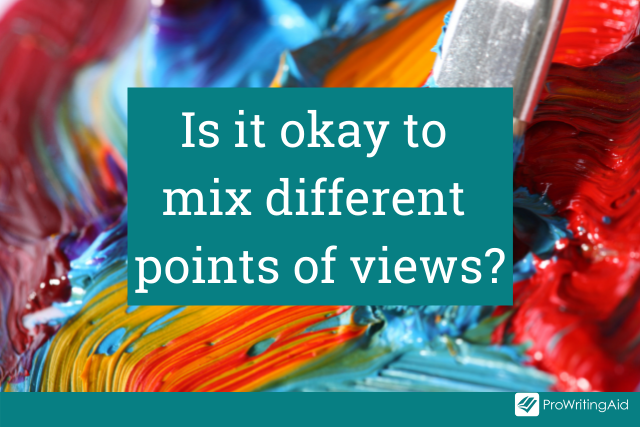
It can be tricky. But it all depends on how you do it for your story and your perspective.
There are plenty of existing books with sections in first-person POV and others with occasional interludes in third-person POV. The trick is to make sure the reader understands what’s going on and that they aren’t taken by surprise as you jump about in your point of view.
The best way to switch points of view is when you start a new chapter and then make it clear in the first few lines of that chapter what POV is in use. In the famous novel The Great Gatsby , F. Scott Fitzgerald’s opening sentence (of the first chapter) clearly shows that the first-person point of view is in use:
"In my younger and more vulnerable years, my father gave me some advice that I’ve been turning over in my mind ever since.”
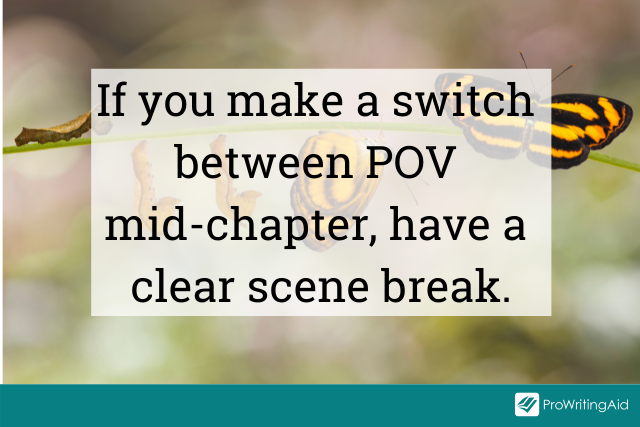
If you make a switch between POV mid-chapter, have a clear scene break. The idea is to avoid swapping into third-person for a few lines then transition back to the protagonist in first-person, then off to another character in another POV. If your novel involves multiple perspectives, you can use ProWritingAid’s Pronoun Check to keep track of all of your clever point of view switches.
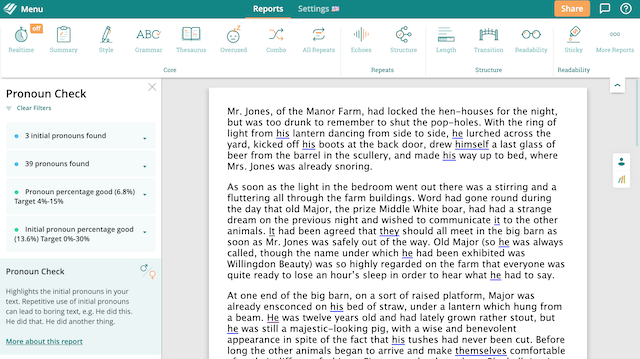
But there are no hard and fast rules for narrative perspectives. Some readers will like the point of view switches, some will not. In the end, it’s down to you and what you think of it. But has this ever been done before? The answer is almost always yes. Charles Dickens did it in his novel Bleak House —and so can you.
1) Read a variety of books that display an effective use of the third-person point of view. Then use those you think are the best as an example—after all, those who want to write have to read books regardless of the narrative perspective they want to master.
Good examples of third-person literature from classic fiction include Pride and Prejudice by Jane Austen, Catch-22 by Joseph Heller, and Moby Dick by Herman Melville.
2) Learn to write with authority. The reader wants a narrator they can fully trust to transition the story to the next chapter or scene with ease. Create an authoritative third-person narrator that sits on the shoulder of the reader—creating a bird’s-eye view of the story.
3) Empower the narrator with a reliable voice and the ability to know the character’s thoughts. This is possible when using third-person omniscient and limited POV.
4) Avoid transitioning into the first-person point of view. The first-person POV uses the pronouns I , me , mine , we , us , our , and more. The third-person POV calls for the author to stay in the narrator character’s voice while staying consistent with the pronouns he , she , it or they .
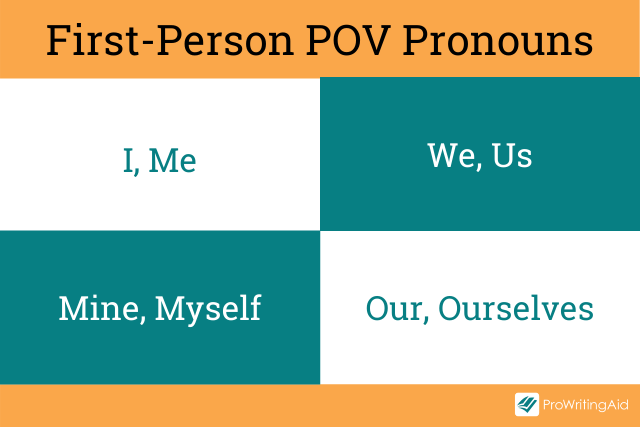
5) Choose the best type of third-person POV for your story and remain consistent. You have the plot and are ready to write. But before you do, think of the third-person perspective that’ll work best for your story.
Are you writing an epic saga with important characters? Use the third-person omniscient POV (with an all-knowing narrator). Do you want to keep your reader in suspense and only know what the character knows? Then write the story in third-person limited POV.

The third-person perspective transcends time. It’s been in use since time immemorial in a wide range of fiction from E. B. White’s children’s tales to George Orwell’s classics Animal Farm and 1984 —and to now J. K. Rowling’s famous magical series.
In fiction, third-person perspective allows the writer to place the reader in the character’s head—explaining all the important plot points and details for the story whilst staying impartial.
"The goose shouted to the nearest cow that Wilbur was free, and soon all the cows knew. Then one of the cows told one of the sheep, and soon all the sheep knew. The lambs learned about it from their mothers. The horses, in their stalls in the barn, pricked up their ears when they heard the goose hollering; and soon the horses had caught on to what was happening." E. B. White, Charlotte’s Web "They all remembered or thought they remembered, how they had seen Snowball charging ahead of them at the Battle of the Cowshed, how he had rallied and encouraged them at every turn, and how he had not paused for an instant even when the pellets from Jones’s gun had wounded his back." George Orwell, Animal Farm "Harry moved in front of the tank and looked intently at the snake. He wouldn’t have been surprised if it had died of boredom itself." J. K. Rowling, Harry Potter and the Philosopher’s Stone
Choosing the right third-person POV can sometimes be challenging, but getting it right can make all the difference. Third-person viewpoint has important advantages in a story:
1) The third-person POV has a wider narrative scope than the first and second. The writer experiences a robust character development because there is a broader range of options for language choice. You can shift a melodramatic moment in an overreacting character’s mind to something that might let the reader sympathize better.
2) The third-person POV allows you to put several characters in the spotlight . You can do this while giving the reader an all-around view of the plot, which creates a rich and complex story by including information the the characters do not know.
3) Third-person POV is more flexible. As a narrator, you can switch between different character stories, helping the reader see everything including thoughts, feelings, and sensations, and you can go everywhere you want. You can go from being omniscient to limited to an objective third-person POV.
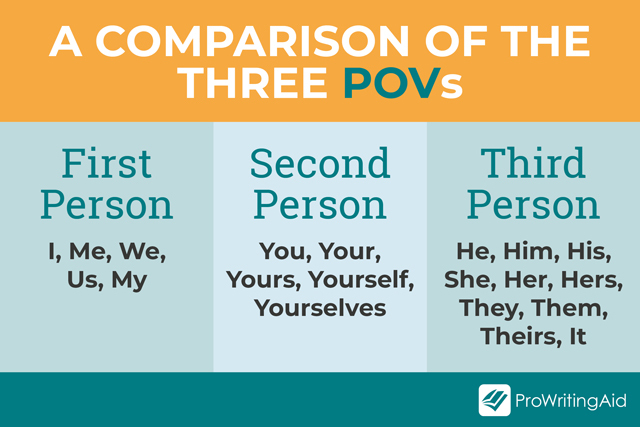
Point Your Story in the Right Direction
Point of view is an important consideration when writing fiction. Writers have favorite points of view, which can become our defaults. This isn’t a problem, as the same POV may suit most of our writing. However, to tell better stories with characters that exude power, it’s important to choose the point of view that has the biggest impact on your story. Try using third-person point of view to bring your writing to life.
Are you prepared to write your novel? Download this free book now:

The Novel-Writing Training Plan
So you are ready to write your novel. excellent. but are you prepared the last thing you want when you sit down to write your first draft is to lose momentum., this guide helps you work out your narrative arc, plan out your key plot points, flesh out your characters, and begin to build your world..

Be confident about grammar
Check every email, essay, or story for grammar mistakes. Fix them before you press send.
Walter Akolo
Walter Akolo is a freelance writer, internet marketer, trainer, and blogger for hire. He loves helping businesses increase their reach and conversion through excellent and engaging content. He has gotten millions of pageviews on his blog, FreelancerKenya, where he mentors writers. Check out his website walterakolo.com.
Get started with ProWritingAid
Drop us a line or let's stay in touch via:
BibGuru Blog
Be more productive in school
- Citation Styles
How to write in third-person

Although there are three narratives you can use in any form of writing when it comes to your papers and anything academic you produce, it’s best to choose the third-person. It’s pretty simple with a bit of practice, but if you’re completely new to this writing style, here’s what you need to know about how to write in third-person.
What does writing in third-person mean?
Writing in third-person is one of the three styles you can use when describing a point of view. Even though you might not know it, chances are you’ve used first, second and third person in writing projects throughout your education.
It’s a narrative where you’re totally independent of the subject you’re analyzing and writing about. You don’t take sides. You don’t try to influence what readers feel. It’s a completely unbiased, objective way of writing that tells a story or dissects a topic right down the middle.
There’s a lot of information out there about how you can differentiate between the three in roundabout ways, making it unnecessarily complicated. Here’s a quick breakdown to understand the differences for when you write your following paper:
First-person
This is from the I/we perspective. It’s where we talk about us , ourselves, and our opinions. If we go down the first-person route, writing will include pronouns like I , me , myself, and mine .
Second-person
This point of view belongs to the person you’re addressing — so its a you perspective. In your writing, you’d use second-person pronouns such as you , your, and yourselves .
Third-person
The third-person point of view is aimed at the person or people being talked about, which is the type of writing you’d find in stories. In this perspective, you’d use pronouns like he , she , him , her , his , hers , himself , herself , it , them , their, and themselves . Or, you’d use a name. But that tends to happen more in stories than research papers.
Notice the difference between the three?
When to write in third-person
The third-person point of view tells the reader a story and it’s often the go-to when you’re taking an authoritative stance in your papers, which is why it’s so common in academic writing.
So, always choose the third-person stance when writing academic copy, such as essays and research papers.
The reason for this is it’ll make your papers less personal and more objective, meaning the objectivity will make you come across as more credible and less biased. Ultimately, this will help your grades as the third-person view keeps you focused on evidence and facts instead of your opinion.
You can break third-person perspectives into three other types, including omniscient, limited, and objective. Although they’re more associated with creative writing than academic work and essays, your writing is likely to fall under the third-person objective point of view.
A third-person objective point of view is about being neutral and presenting your findings and research in an observational way, rather than influencing the reader with your opinions.
How to use the third-person point of view
Rule number one: Never refer to yourself in your essay in the third-person. That’s a no-no.
For instance, here’s how you shouldn’t write a sentence in your essay if you’re writing about virtual learning as an example.
“I feel like students perform better at home because they have more freedom and are more comfortable.”
It’s a simple sentence, but there’s a lot wrong with it when you’re talking about research papers and adopting a third-person narrative. Why? Because you’re using first-person pronouns and, as it sounds like an opinion, you can’t back up your claims with a stat or any credible research. There’s no substance to it whatsoever.
Also, it isn’t very assertive. The person marking your work won’t be impressed by “I feel like,” because it shows no authority and highlights that it came from your brain and not anywhere of note.
By including terms like “I think” or “I feel” like in the example above, you’re already off to a bad start.
But when you switch that example to the third-person point of view, you can cite your sources , which is precisely what you need to do in your essays and research papers to achieve higher grades.
Let’s switch that sentence up and expand it using the third-person point of view:
“A psychological study from Karrie Goodwin shows that students thrive in virtual classrooms as it offers flexibility. They can make their own hours and take regular breaks. Another study from high school teacher, Ashlee Trip, highlighted that children enjoy freedom, the ability to work at their own pace and decide what their day will look like.”
With a third-person narrative, you can present evidence to the reader and back up the claims you make. So, it not only shows what you know, but it also shows you took the time to research and strengthen your paper with credible resources and facts — not just opinions.
6 tips for writing in third-person
1. understand your voice won’t always shine in your essays.
Every single piece of writing tends to have a voice or point of view as if you’re speaking to the reader directly. However, that can’t always happen in academic writing as it’s objective compared to a novel, for example. Don’t try to ‘fluff’ up your piece to try and cram your personality in, as your academic work doesn’t need it.
2. Don’t focus on yourself or the reader — focus on the text
An academic piece of work always has a formal tone as it’s objective. When you write your next paper, focus on the writing itself rather than the writer or the reader.
3. Coach yourself out of using first-person pronouns
This is easier said than done if all you’ve ever done is first- or second-person writing. When you write your next paper, scan through it to see if you’ve written anything in first-person and replace it with the third-person narrative.
Here are a few regular offenders that pop up in academic papers — along with how you can switch the statements to third-person:
- I argue should be this essay argues
- I found that should be it was found that
- We researched should be the group researched
- I will also analyze should be topic X will also be analyzed
The same applies to second-person, as there are plenty of cases where it tends to slip through in academic writing. Again, it’s pretty straightforward to switch the more you practice. For instance:
- Your paper will be marked higher if you use a citation tool should be the use of a citation tool will improve one’s grades
4. Be as specific as possible
This is where things can get a little bit confusing. Writing in third-person is all about including pronouns like he, she, it, and they. However, using them towards the beginning of sentences can be pretty vague and might even confuse the reader — this is the last thing you want from your essay or paper.
Instead, try using nouns towards the beginning of sentences. For example, use the actual subject, such as the interviewer or the writer, rather than he, she, or they when you begin the sentence.
The same applies to terms like it. Start the sentence with the ‘it’ is that you’re describing. If it’s a citation tool, begin the sentence by referencing what you’re discussing, so you aren’t vague. Clarity is key.
5. Write in the present tense when using third-person
In any form of academic writing, you need to write your reports, essays, and research papers in the present tense, especially when introducing different subjects or findings.
So, rather than saying “This paper analyzed” (which does seem correct as technically that part was in the past and the writing is in the present), you should write “This report analyzes” — as if you’re analyzing right here and now.
However, the difference is when you highlight how you did the research, that should be in the past tense. This means you’d use third-person phrases like “The equipment that was used” or “The results were analyzed by”, for instance.

6. Avoid adding your own thoughts
If your report is on a subject that’s close to your heart, it can be super tempting to sprinkle in your own thoughts. It’s a challenge, but you need to coach yourself out of it.
In academic writing, you aren’t a commentator. You’re a reporter. You need to let readers draw their conclusions without over-analyzing them or making the reader lean one way or another.
The easiest way to get to grips with writing your academic papers in the third-person is to be consistent and practice often. Criticize your work and analyze it until it becomes the norm. Yes, it can be a little complex in the early days, but before you know it, you’d have mastered the technique, helping you take your papers and reports up a level.
Frequently Asked Questions about writing in third-person
In third-person, you’d use pronouns like he , she , him , her , his , hers , himself , herself , it , them , their, and themselves . Or, you’d use a name.
You is used in second person and is therefore not used in third person. The second person is used for the person that is being addressed.
The third-person point of view is aimed at the person or people being talked about, which is the type of writing you’d find in stories. When writing in third-person view, make sure to write in the present tense and avoid adding your own thoughts.
When writing in third person, you should actually always write in the present tense since you are mostly presenting results in this view.
The second person point of view belongs to the person you’re addressing — so its a you perspective. In your writing, you’d use second-person pronouns such as you , your, and yourselves .

Make your life easier with our productivity and writing resources.
For students and teachers.
7 Essential Tips for Writing in the Third Person

Table of contents

Alana Chase
Whether you’re a student, business professional, or writer, knowing how to write well in the third person is an essential skill.
But you may not be sure of all the rules or how to make your third-person writing shine.
As an editor and writing coach of 11 years, I’ve taught students and writers at all levels how to master the third-person point of view (POV). All you need to get started is a good understanding of third-person pronouns and a bit of practice for consistency.
By the end of this article, you’ll know when and how to use third-person perspective. You'll also find helpful tips for taking your third-person writing to the next level.
Key takeaways
- In the third-person perspective, the narrator is separate from the story.
- Third-person perspective uses he/him/his, she/her/hers, and they/them/their pronouns.
- Consistency is key: Don’t switch between perspectives in a single document.
- Practicing third-person writing and editing your work is vital to improving your skills.
What is third-person point of view (POV)?
In writing, there are three ways to tell a story: first-person, second-person, or third-person POV.
First-person POV is from the narrator’s perspective:
“ I saw the bird steal my sandwich, and I ran after it.”
Second-person POV is from the reader’s perspective:
“ You saw the bird steal your sandwich, and you ran after it.”
Third-person POV, however, separates the narrator from the story and uses third-person pronouns (like he/him, she/her, and they/them) to describe events, actions, thoughts, and emotions. Characters are referred to by name or one of these pronouns:
“ Alex saw the bird steal his/her/their sandwich, and he/she/they ran after it.”
Third-person POV is used in all kinds of writing — from novels to research papers, journalistic articles, copywriting materials, and more. Check out some examples below.
Examples of third-person perspective
- In a novel: “Robb and Jon sat tall and still on their horses, with Bran between them on his pony, trying to seem older than seven, trying to pretend that he’d seen all this before.” (From A Game of Thrones by George R. R. Martin)
- In a news article : “This weekend, Iceland experienced nearly 2,000 earthquakes within 48 hours. And they’ve kept coming since then – in swarms.” (From “Thousands of earthquakes have scientists watching for a volcanic eruption in Iceland” on NPR’s website )
- In copywriting : “Balm Dotcom’s formula has antioxidants and natural emollients to nourish dry lips.” (Website copy describing Glossier’s Balm Dotcom lip product )
7 tips for writing in the third person
Just like the first and second person, you’ve probably already written in the third person before. But to do it well , you’ll need some key tips and tricks in your writing toolkit.
Let’s dive into the seven essentials for third-person writing.
Tip 1: Use third-person determiners and pronouns
In grammar, determiners introduce and modify nouns. They’re used to specify what a noun refers to (like “ my laptop”) or the quantity of it (like “ many sandwiches”).
Meanwhile, pronouns are substitutes for nouns, referring to people, places, or things. For example, “Caroline [noun] is a skilled musician, and she [pronoun] especially loves playing the piano.”
When you write in the third person, use only third-person determiners and pronouns. Let’s take a look at the different types of pronouns.

Tip 2: Use names for clarity
In third-person writing, using names is crucial for clarity, especially when multiple people/characters share similar pronouns. Strategically incorporate names into your writing to help readers keep track of who’s who.
For example:
“She submitted the script draft to her, and she made suggestions for changes.”
“Mira submitted the script draft to Lynn, and Lynn made suggestions for changes.”
Tip: Use a character or person’s name when introducing them in your writing. Then, alternate between using pronouns and their name to prevent confusion.
Tip 3: Keep the narration neutral
When you write in the third person, your narrator is an uninvolved observer. They have no opinions on the people, places, things, or events they describe. Their words and tone should be neutral (but not boring).
To achieve this in your writing:
- Think of your narrator as a reporter. Their job is to detail what’s happening, when and why it’s occurring, who’s involved, and any background information that can give context. They don’t offer a personal interpretation of events. Instead, they provide facts and supporting details.
- Save the judgment for characters. Rather than having your narrator share their critique of events or individuals, have a character offer their opinion — either through dialogue, actions, or reactions. For instance, instead of writing, “Dr. Shaw was a courageous woman,” let a character convey admiration by telling Dr. Shaw, “I’ve always admired your fearlessness.”
- Be objective with your descriptions. Avoid subjective adjectives and focus on observable features. For example, instead of describing a landscape as “breathtaking,” write that it’s “marked with snow-capped mountains and patches of tall pine trees.”
Tip 4: Use descriptive language
Showing — and not just telling — is essential when writing in the third person. Instead of stating emotions and experiences outright, immerse your reader in your character’s reality. Create vivid descriptions of their thoughts, feelings, and surroundings. Use language that engages the senses: sight, sound, smell, touch, and taste.
For example:
“Aisha was nervous.”
“Aisha’s hands trembled, and her tongue felt dry against the roof of her mouth. The spotlight above the stage shone white-hot, causing beads of sweat to form along Aisha’s hairline.”
Tip 5: Be consistent
Once you establish a third-person POV, stick to it . Avoid switching from the third person to the first or second person. Otherwise, you’ll confuse the reader and disrupt the flow of your writing.
“Hannah felt a surge of excitement when her telephone rang, anticipating good news about her mortgage application. I felt my heart rate quicken as I answered.” (Switches from the third person to the first person)
“Hannah felt a surge of excitement when her telephone rang, anticipating good news about her mortgage application. She felt her heart rate quicken as she answered.” (Remains in the third person)
Tip 6: Practice
Writing in the third person might feel strange at first, especially if you’re used to using the first or second person. However, it’ll come more naturally to you with practice.
Here are two writing exercises you can try right now:
Writing Exercise #1
Take an excerpt from an article or book written in the first or second person and rewrite it in the third person. Below is an example using The Catcher in the Rye , whose main character is named Holden.
Before: “The other reason I wasn’t down at the game was because I was on my way to say good-by to old Spencer, my history teacher.”
After: “The other reason Holden wasn’t down at the game was because he was on his way to say good-by to old Spencer, his history teacher.”
Writing Exercise #2
Turn on a movie or television show, mute the sound, and closely observe two characters. Give them each a name. Using third-person pronouns and their names, describe the characters’ actions and what you believe they’re thinking and feeling.
Above all, write in the third person as often as possible , following the tips in this guide. Remember, your writing skills are like muscles: The more you exercise them, the stronger they become.
Tip 7: Carefully revise
After you’ve written something in the third person, carefully review and revise your work.
Check that your writing :
- Uses third-person determiners and pronouns accurately and consistently
- Incorporates names where pronouns may cause confusion
- Maintains a neutral tone, where your narrator doesn’t offer personal opinions or interpretations
- Doesn’t shift to the first or second person
Make changes where necessary, then read through your work a final time.
AI tip: Wordtune can help you self-edit and help improve your writing overall.
Paste your work into Wordtune’s Editor, or write in it directly, and use the features to shorten or expand your sentences, make your tone more casual or formal, and more. Wordtune will also automatically flag spelling and grammar errors and suggest ways to improve concision, clarity, and flow.

Get Wordtune for free > Get Wordtune for free >
Bonus tip (advanced): Learn the different types of third-person POV
Did you know there are three types of third-person POV? Getting familiar with them can help you make your writing even more impactful.
- Third-person objective , where the narrator is “a fly on the wall”: They provide an objective account of events without exploring people/characters’ emotions or thoughts.
- Third-person omniscient , where the narrator has unlimited knowledge of all events and characters’ thoughts and feelings.
- Third-person limited , also called “close third,” where the narrator has access to just one character’s emotions, thoughts, and experiences.
With this knowledge, you can choose the right perspective for your writing depending on its purpose, tone, and goals.
For instance, use third-person omniscient to show readers what’s happening with everyone in your novel. Or, you could go for third-person objective in an academic paper where you must present facts without sharing your interpretation of them.
Writing well in the third person takes thought and effort. You must use third-person determiners and pronouns, weave in descriptive language, and keep your narration neutral. You also need to be consistent with your POV, ensuring you don’t accidentally switch to the first or second person. Finally, review and revise your work to make sure it’s clear and error-free.
Using this guide — and Wordtune’s tools to polish your writing — you’ll get the hang of the third-person perspective in no time.
To continue sharpening your writing skills, read our articles on mastering tone of voice and writing concisely (with help from AI). Then, check out our proofreading guide to keep your work flawless .
What is a third-person word example?
Third-person words are pronouns like “he,” “her,” “they,” “it,” “hers,” and “theirs.”
Should I write in the first or third person?
It depends on the closeness you want to create with your audience. The first person allows for a personal connection between the narrator and the reader, while the third person creates distance between the narrator and the audience.
What are the disadvantages of writing in the third person?
Third-person writing can lead to a lack of intimacy with the reader. This can be a disadvantage for some writers but an advantage for others, like those in academic and professional settings.
Share This Article:
%20(1).webp)
8 Tips for E-commerce Copywriting Success (with Examples!)
.webp)
The Brand Strategy Deck You Need to Drive Social Media Results + 5 Examples

Grammarly Alternatives: Which Writing Assistant is the Best Choice for You?
Looking for fresh content, thank you your submission has been received.
- PRO Courses Guides New Tech Help Pro Expert Videos About wikiHow Pro Upgrade Sign In
- EDIT Edit this Article
- EXPLORE Tech Help Pro About Us Random Article Quizzes Request a New Article Community Dashboard This Or That Game Happiness Hub Popular Categories Arts and Entertainment Artwork Books Movies Computers and Electronics Computers Phone Skills Technology Hacks Health Men's Health Mental Health Women's Health Relationships Dating Love Relationship Issues Hobbies and Crafts Crafts Drawing Games Education & Communication Communication Skills Personal Development Studying Personal Care and Style Fashion Hair Care Personal Hygiene Youth Personal Care School Stuff Dating All Categories Arts and Entertainment Finance and Business Home and Garden Relationship Quizzes Cars & Other Vehicles Food and Entertaining Personal Care and Style Sports and Fitness Computers and Electronics Health Pets and Animals Travel Education & Communication Hobbies and Crafts Philosophy and Religion Work World Family Life Holidays and Traditions Relationships Youth
- Browse Articles
- Learn Something New
- Quizzes Hot
- Happiness Hub
- This Or That Game
- Train Your Brain
- Explore More
- Support wikiHow
- About wikiHow
- Log in / Sign up
- Education and Communications
- Editing and Style
How to Write in Third Person
Last Updated: September 3, 2024 Fact Checked
This article was co-authored by Alicia Cook . Alicia Cook is a Professional Writer based in Newark, New Jersey. With over 12 years of experience, Alicia specializes in poetry and uses her platform to advocate for families affected by addiction and to fight for breaking the stigma against addiction and mental illness. She holds a BA in English and Journalism from Georgian Court University and an MBA from Saint Peter’s University. Alicia is a bestselling poet with Andrews McMeel Publishing and her work has been featured in numerous media outlets including the NY Post, CNN, USA Today, the HuffPost, the LA Times, American Songwriter Magazine, and Bustle. She was named by Teen Vogue as one of the 10 social media poets to know and her poetry mixtape, “Stuff I’ve Been Feeling Lately” was a finalist in the 2016 Goodreads Choice Awards. This article has been fact-checked, ensuring the accuracy of any cited facts and confirming the authority of its sources. This article has been viewed 1,155,295 times.
Writing in third person can be a simple task, with a little practice. For academic purposes, third person writing means that the writer must avoid using subjective pronouns like “I” or “you.” For creative writing purposes, there are differences between third person omniscient, limited, objective, and episodically limited points of view. Choose which one fits your writing project.
Writing Third Person Point of View
The third-person point of view discusses the person or people being talked about in academic or creative writing. In this perspective, you’d shift focus from subject to subject. Use pronouns like he/him, she/her, they/them, or it/itself.
Writing in Third Person Academically

- Third person helps the writing stay focused on facts and evidence instead of personal opinion.

- Third person pronouns include: he, she, it; his, her, its; him, her, it; himself, herself, itself; they; them; their; themselves.
- Names of other people are also considered appropriate for third person use.
- Example: “ Smith believes differently. According to his research, earlier claims on the subject are incorrect.”

- First person pronouns include: I, me, my, mine, myself, we, us, our, ours, ourselves. [2] X Research source
- The problem with first person is that, academically speaking, it sounds too personalized and too subjective. In other words, it may be difficult to convince the reader that the views and ideas being expressed are unbiased and untainted by personal feelings. Many times, when using first person in academic writing, people use phrases like "I think," "I believe," or "in my opinion."
- Incorrect example: “Even though Smith thinks this way, I think his argument is incorrect.”
- Correct example: “Even though Smith thinks this way, others in the field disagree.”

- Second person pronouns include: you, your, yours, yourself. [3] X Research source
- One main problem with second person is that it can sound accusatory. It runs to risk of placing too much responsibility on the shoulders of the reader specifically and presently reading the work.
- Incorrect example: “If you still disagree nowadays, then you must be ignorant of the facts.”
- Correct example: “Someone who still disagrees nowadays must be ignorant of the facts.”

- Indefinite third person nouns common to academic writing include: the writer, the reader, individuals, students, a student, an instructor, people, a person, a woman, a man, a child, researchers, scientists, writers, experts.
- Example: “In spite of the challenges involved, researchers still persist in their claims.”
- Indefinite third person pronouns include: one, anyone, everyone, someone, no one, another, any, each, either, everybody, neither, nobody, other, anybody, somebody, everything, someone.
- Incorrect example: "You might be tempted to agree without all the facts."
- Correct example: “ One might be tempted to agree without all the facts.”
- This is usually done in an attempt to avoid the gender-specific “he” and “she” pronouns. The mistake here would be to use the “they” pronoun with singular conjugation. [4] X Research source
- Incorrect example: “The witness wanted to offer anonymous testimony. They was afraid of getting hurt if their name was spread.”
- Correct example: “The witness wanted to offer anonymous testimony. They were afraid of getting hurt if their name was spread.”
Writing in Third Person Omniscient

- For instance, a story may include four major characters: William, Bob, Erika, and Samantha. At various points throughout the story, the thoughts and actions of each character should be portrayed. These thoughts can occur within the same chapter or block of narration.
- Writers of omniscient narratives should be conscious of “head-hopping” — that is, shifting character perspectives within a scene. While this does not technically break the rules of Third Person Omniscience, it is widely considered a hallmark of narrative laziness.
- In a sense, the writer of a third person omniscient story is somewhat like the “god” of that story. The writer can observe the external actions of any character at any time, but unlike a limited human observer, the writer can also peek into the inner workings of that character at will, as well.
- Know when to hold back. Even though a writer can reveal any information they choose to reveal, it may be more beneficial to reveal some things gradually. For instance, if one character is supposed to have a mysterious aura, it would be wise to limit access to that character's inner feelings for a while before revealing his or her true motives.

- Do not use first person and second person points of view in the narrative or descriptive portions of the text.
- Correct example: Bob said to Erika, “I think this is creepy. What do you think?”
- Incorrect example: I thought this was creepy, and Bob and Erika thought so, too. What do you think?
Writing in Third Person Limited

- The thoughts and feelings of other characters remain an unknown for the writer throughout the duration of the text. There should be no switching back and forth between characters for this specific type of narrative viewpoint.
- Unlike first person, where the narrator and protagonist are the same, third person limited puts a critical sliver of distance between protagonist and narrator. The writer has the choice to describe one main character’s nasty habit — something they wouldn’t readily reveal if the narration were left entirely to them.

- In other words, do not use first person pronouns like “I,” “me,” “my,” “we,” or “our” outside of dialog. The main character's thoughts and feelings are transparent to the writer, but that character should not double as a narrator.
- Correct example: “Tiffany felt awful after the argument with her boyfriend.”
- Correct example: “Tiffany thought, “I feel awful after that argument with my boyfriend.”
- Incorrect example: “I felt awful after the argument with my boyfriend.”

- Note that the writer can offer insight or guesses regarding the thoughts of other characters, but those guesses must be presented through the perspective of the main character.
- Correct example: “Tiffany felt awful, but judging by the expression on Carl's face, she imagined that he felt just as bad if not worse.”
- Incorrect example: “Tiffany felt awful. What she didn't know was that Carl felt even worse.”

- Correct example: “Tiffany watched from the window as Carl walked up to her house and rang the doorbell.”
- Incorrect example: “As soon as Tiffany left the room, Carl let out a sigh of relief.”
Writing in Episodically Limited Third Person

- Limit the amount of pov characters you include. You don't want to have too many characters that confuse your reader or serve no purpose. Each pov character should have a specific purpose for having a unique point of view. Ask yourself what each pov character contributes to the story.
- For instance, in a romance story following two main characters, Kevin and Felicia, the writer may opt to explain the inner workings of both characters at different moments in the story.
- One character may receive more attention than any other, but all main characters being followed should receive attention at some point in the story.

- Multiple perspectives should not appear within the same narrative space. When one character's perspective ends, another character's can begin. The two perspectives should not be intermixed within the same space.
- Incorrect example: “Kevin felt completely enamored of Felicia from the moment he met her. Felicia, on the other hand, had difficulty trusting Kevin.”

- In a novel-length work, a good time to switch perspective is at the start of a new chapter or at a chapter break.
- The writer should also identify the character whose perspective is being followed at the start of the section, preferably in the first sentence. Otherwise, the reader may waste too much energy guessing.
- Correct example: “Felicia hated to admit it, but the roses Kevin left on her doorstep were a pleasant surprise.”
- Incorrect example: “The roses left on the doorstep seemed like a nice touch.”

- For instance, if Kevin had a talk with Felicia's best friend about Felicia's feelings for him, Felicia herself would have no way of knowing what was said unless she witnessed the conversation or heard about it from either Kevin or her friend.
Writing in Third Person Objective

- There does not need to be a single main character to focus on. The writer can switch between characters, following different characters throughout the course of the narrative, as often as needed.
- Stay away from first person terms like “I” and second person terms like “you” in the narrative, though. Only use first and second person within dialog.

- Imagine that you are an invisible bystander observing the actions and dialog of the characters in your story. You are not omniscient, so you do not have access to any character's inner thoughts and feelings. You only have access to each character's actions.
- Correct example: “After class, Graham hurriedly left the room and rushed back to his dorm room.”
- Incorrect example: “After class, Graham raced from the room and rushed back to his dorm room. The lecture had made him so angry that he felt as though he might snap at the next person he met.”

- Correct example: “When no one else was watching her, Isabelle began to cry.”
- Incorrect example: “Isabelle was too prideful to cry in front of other people, but she felt completely broken-hearted and began crying once she was alone.”

- Let the reader draw his or her own conclusions. Present the actions of the character without analyzing them or explaining how those actions should be viewed.
- Correct example: “Yolanda looked over her shoulder three times before sitting down.”
- Incorrect example: “It might seem like a strange action, but Yolanda looked over her shoulder three times before sitting down. This compulsive habit is an indication of her paranoid state of mind.”
Examples of Third Person POV

Expert Q&A

You Might Also Like

- ↑ https://stlcc.edu/student-support/academic-success-and-tutoring/writing-center/writing-resources/point-of-view-in-academic-writing.aspx
- ↑ http://www.grammar-monster.com/glossary/third_person.htm
- ↑ https://www.grammarly.com/blog/use-the-singular-they/
- ↑ Alicia Cook. Professional Writer. Expert Interview. 11 December 2020.
- ↑ https://www.merriam-webster.com/words-at-play/point-of-view-first-second-third-person-difference
- ↑ https://ojs.library.dal.ca/YAHS/article/viewFile/7236/6278
About This Article

To write in third person, refer to people or characters by name or use third person pronouns like he, she, it; his, her, its; him, her, it; himself, herself, itself; they; them; their; and themselves. Avoid first and second person pronouns completely. For academic writing, focus on a general viewpoint rather than a specific person's to keep things in third person. In other types of writing, you can write in third person by shifting your focus from character to character or by focusing on a single character. To learn more from our Literary Studies Ph.D., like the differences between third person omniscient and third person limited writing, keep reading the article! Did this summary help you? Yes No
- Send fan mail to authors
Reader Success Stories
Jul 31, 2016
Did this article help you?

Jean Scicluna
Jan 31, 2021
Nov 4, 2016
Karen Evans
Aug 5, 2016
Oct 20, 2016

Featured Articles

Trending Articles

Watch Articles

- Terms of Use
- Privacy Policy
- Do Not Sell or Share My Info
- Not Selling Info
wikiHow Tech Help Pro:
Level up your tech skills and stay ahead of the curve
Point of View: It's Personal
What to Know The point of view of a story determines who is telling it and the narrator's relationship to the characters in the story. In first person point of view the narrator is a character in the story telling it from their perspective. In third person point of view the narrator is not part of the story and the characters never acknowledge the narrator's presence. Less common than first and third is second person point of view. In second person point of view the reader is part of the story. The narrator describes the reader's actions, thoughts, and background using "you."

It's all about how you look at it.
When you tell a story, an important thing to choose is the point of view that the story should take. Point of view determines who tells the story, as well as the relationship that the narrator has to the characters in the story. A story can have a much different feel depending on who is doing the telling.
The main points of view are first person and third person, with second person appearing less frequently but still common enough that it gets studied in writing classes. These are also the terms used to distinguish the personal pronouns. The pronouns I and we are first-person pronouns; they refer to the self. The pronoun you , used for both singular and plural antecedents, is the second-person pronoun, the person who is being addressed. The third person pronouns— he , she , it , they —refer to someone or something being referred to apart from the speaker or the person being addressed. Narratives are often identified as first, second, or third person based on the kinds of pronouns they utilize.
First Person Point of View
In first-person narration, the narrator is a person in the story, telling the story from their own point of view. The narration usually utilizes the pronoun I (or we , if the narrator is speaking as part of a group). The character who tells the story might be in the middle of the action or more of a character who observes the action from the outer limits, but in either case you are getting that character’s recounting of what happens.
It also means that impressions and descriptions are colored by that character’s opinions, mood, past experiences, or even their warped perceptions of what they see and hear.
There was no possibility of taking a walk that day. We had been wandering, indeed, in the leafless shrubbery an hour in the morning; but since dinner (Mrs. Reed, when there was no company, dined early) the cold winter wind had brought with it clouds so sombre, and a rain so penetrating, that further outdoor exercise was now out of the question. I was glad of it: I never liked long walks, especially on chilly afternoons: dreadful to me was the coming home in the raw twilight, with nipped fingers and toes, and a heart saddened by the chidings of Bessie, the nurse, and humbled by the consciousness of my physical inferiority to Eliza, John, and Georgiana Reed. — Charlotte Brontë, Jane Eyre , 1847
In Jane Eyre , the narration is provided by the story’s title character, a governess. The information shared comes from her memories and impressions—of the weather, her knowledge of Mrs. Reed’s dining habits, and her dread at receiving a lecture from Nurse Bessie. We are likewise shielded from information that Jane doesn’t know.
Many classic works of fiction feature characters made memorable by their first-person voices: The Catcher in the Rye (Holden Caulfield), The Handmaid's Tale (Offred), or To Kill a Mockingbird (Scout Finch). In some stories, such as in F. Scott Fitzgerald's The Great Gatsby , the first person narrator (Nick Carraway) is an observer of the character around whom the story is centered (Jay Gatsby).
Second Person
Second-person narration is a little-used technique of narrative in which the action is driven by a character ascribed to the reader, one known as you . The reader is immersed into the narrative as a character involved in the story. The narrator describes what "you" do and lets you into your own thoughts and background. The most well-known piece of fiction that employs second-person narration might be Jay McInerney’s novel Bright Lights, Big City .
At the subway station you wait fifteen minutes on the platform for a train. Finally a local, enervated by graffiti, shuffles into the station. You get a seat and hoist a copy of the New York Post. The Post is the most shameful of your several addictions. — Jay McInerney, Bright Lights, Big City , 1984
You will also find second-person narration used in the "Choose Your Own Adventure" style of books popular with younger readers, in which readers determine where the story goes by which page they turn to next. Allowing the reader to "be" the central character in the story provides an immersive reading experience, enhancing what is at stake for the character and reader.
Third Person Point of View
In third-person narration, the narrator exists outside the events of the story, and relates the actions of the characters by referring to their names or by the third-person pronouns he, she, or they.
Third-person narration can be further classified into several types: omniscient, limited, and objective.
Third Person Omniscient
Omniscient means "all-knowing," and likewise an omniscient narrator knows every character’s thoughts, feelings, and motivations even if that character doesn’t reveal any of those things to the other characters.
Little Women by Louisa May Alcott serves as a good example of third-person omniscient narration:
"Christmas won't be Christmas without any presents," grumbled Jo, lying on the rug. "It's so dreadful to be poor!" sighed Meg, looking down at her old dress. "I don't think it's fair for some girls to have plenty of pretty things, and other girls nothing at all," added little Amy, with an injured sniff. "We've got Father and Mother, and each other," said Beth contentedly from her corner. The four young faces on which the firelight shone brightened at the cheerful words, but darkened again as Jo said sadly, "We haven't got Father, and shall not have him for a long time." She didn't say "perhaps never," but each silently added it, thinking of Father far away, where the fighting was. — Louisa May Alcott, Little Women , 1868
The story is not told from the point of view of Meg, Jo, Beth, or Amy, but from someone who is observing the four sisters as they talk to one another. Each character is therefore referred to by their names or the third-person pronoun she . The narrator does not exist as a character in the story, and the girls do not acknowledge the narrator’s presence.
However, the narrator is omniscient, which means that they know what the characters are thinking. This is demonstrated in the last line of the excerpt, when the girls silently ponder the thought of their father never returning from the war.
Third Person Limited
In third-person limited narration, the narrator still exists outside the events of the story, but does not know the motivations or thoughts of all the characters. Rather, one character is the driver of the story, and the reader is given a closer peek into that character’s psyche than the others.
J. K. Rowling utilizes third-person limited narration in the Harry Potter novels. Even though the narrator is not Harry, and Harry is referred to as 'he,' the reader is allowed into Harry's thoughts—what he is wondering without saying out loud. We are also, like Harry, left uncertain about what other characters are thinking:
Three days later, the Dursleys were showing no sign of relenting, and Harry couldn't see any way out of his situation. He lay on his bed watching the sun sinking behind the bars on the window and wondered miserably what was going to happen to him. What was the good of magicking himself out of his room if Hogwarts would expel him for doing it? Yet life at Privet Drive had reached an all-time low. Now that the Dursleys knew they weren't going to wake up as fruit bats, he had lost his only weapon. Dobby might have saved Harry from horrible happenings at Hogwarts, but the way things were going, he'd probably starve to death anyway. — J. K. Rowling, Harry Potter and the Chamber of Secrets , 1999
Third-Person Objective
In third-person objective narration, the narrator reports the events that take place without knowing the motivations or thoughts of any of the characters. We know little about what drives them until we hear them speak or observe their actions. The resulting tone is often matter-of-fact, not colored by any opinions or commentary, nor of knowledge of what takes place outside the scene.
The people of the village began to gather in the square, between the post office and the bank, around ten o'clock; in some towns there were so many people that the lottery took two days and had to be started on June 25th. But in this village, where there were only about three hundred people, the whole lottery took less than two hours, so it could begin at ten o'clock in the morning and still be through in time to allow the villagers to get home for noon dinner. — Shirley Jackson, "The Lottery," 1948
Word of the Day
See Definitions and Examples »
Get Word of the Day daily email!
Games & Quizzes

Usage Notes
Prepositions, ending a sentence with, hypercorrections: are you making these 6 common mistakes, a comprehensive guide to forming compounds, can ‘criteria’ ever be singular, singular nonbinary ‘they’: is it ‘they are’ or ‘they is’, grammar & usage, every letter is silent, sometimes: a-z list of examples, how to use em dashes (—), en dashes (–) , and hyphens (-), the difference between 'i.e.' and 'e.g.', plural and possessive names: a guide, 31 useful rhetorical devices, pilfer: how to play and win, 8 words with fascinating histories, flower etymologies for your spring garden, 8 words for lesser-known musical instruments, it's a scorcher words for the summer heat.
Improve your writing in one of the largest and most successful writing groups online
Join our writing group!
How to Write in Third Person Multiple PoV: Examples & Meaning

by Alex Cabal
Alex Cabal is the founder and CEO of Scribophile, one of the web’s oldest and largest writing communities, and the editor-in-chief of Standard Ebooks , a volunteer-led project that creates commercial-quality public domain ebooks for free distribution.
Third person multiple provides your readers with varying points of view, to enrich your plotline and familiarize readers with what’s happening in your characters’ heads and hearts. As the author, you’re already in your characters’ heads. Third person multiple PoV is what will bring your readers there, too.
Leveraging third person multiple PoV is a heavy-hitting strategy of the greats like Tolkien and more. When executed properly, this shifting perspective will bring your readers further into the inner worlds of your characters.
In this article, we’ll focus on how to write in third person point of views and being able to do so with multiple characters—or simply put, “third person multiple PoV.” We’ll go through the advantages and disadvantages, tips, rules, and examples. By the end, you should be well on your way to using this powerful tool to breathe new life into your work and enhance your storytelling.
What is the Third Person Multiple PoV?
Third-person multiple PoV is a narrative point of view in which the narrator follows several different characters using the pronouns “she,” “he,” or “they.” The story alternates between various characters such as two love interests, a protagonist and antagonist, or a group of friends. Unlike omniscient PoV, the narrator can only see inside the head of one character at one time.

Multiple third person PoV involves writing separate scenes from the viewpoints of each of your characters . The author must stay in the one characters’ head for the entire scene and maintain proper PoV rules, such as not relaying to the reader what the thoughts of the opposite character are.
Advantages and disadvantages of Third Person Multiple Point of View
As with any style of PoV, there are different advantages and disadvantages when writing in third person multiple.
One advantage is the ability to move into each of your characters’ heads, giving an in-depth look at characters who normally may not have the chance to voice their thoughts. It provides you, the writer, the opportunity to grow and develop a character every time you get in their head. The reader learns first-hand not just why the character is doing something and why they’re acting a certain way, but they also learn more intimate details about the character as the reader witnesses the character’s inner thoughts.
Say, for instance, you’re reading a crime thriller written in third person multiple PoV. The reader is then able to follow along with both the antagonist and the protagonist, and watch what drives them both to make the decisions they do. The reader will be in the head of the killer when they commit their crimes, get to know them as an individual, and—if the author is skilled—learn about the character on a whole different level than they would have had the author not used this PoV. This makes the overall storytelling more effective and compelling.
That said, using third person multiple isn’t always necessarily advantageous, with pitfalls that many new and seasoned authors alike can fall into. Choosing whether or not to use this shifting perspective will depend on your genre, plotline, and what you want your readers to feel or know at any given moment.
Third Person Point of View pros
Multiple points of view allow your reader to learn what drives each of your characters to do things they may do.
It helps the author to broaden the scope of who should be included in the story, from main characters to secondary ones.
Different third person points of view keep up the tension. You don’t want your readers bored, and this PoV lets you shift perspectives in different scenes, keeping the reader on their toes and providing them with more dynamic insight into the plot.
It keeps the pace moving. You want your plot to move briskly and you want your reader looking forward to the next chapter. Moving from one character to another gives the story that momentum.
Third person PoV offers the reader a variety of perspectives and can make a story more complex and intriguing for a reader. For example, allowing the reader to watch the antagonist plot his crimes, while in tandem, showing the intricate details of what drives the hero or heroine.
Third Person Point of View cons
As an author, you have to stay on your toes and methodically maintain a character’s PoV in each scene, rather than head-hopping between characters and confusing your reader with too many perspectives at once.
If you shift PoV too much, you can lose momentum, and ultimately, the reader.
Shifting third person can sometimes put emotional emphasis on the wrong characters. If you’re attempting to shift perspective simply for the sake of it, you risk throwing your character development out of whack.
The third person multiple PoV won’t be applicable to all genres. It’s obviously not ideal for memoir-style fiction, books for younger readers, and novels with parallel narratives that are better off in the first person.
Should I use Third Person Multiple Pov?
An author who’s mastered the third person multiple PoV can wind up with a really compelling story. Getting into the heads of characters can help the reader grow to love them almost as much as the author who created them did. If you can nail the third person multiple, your readers will have a better understanding of the inner workings of the hearts and minds of your characters. Whether they grow to love or hate them, readers will be emotionally invested.
If you have more than one character (you probably do) with whom you want your readers to intimately connect, third person multiple PoV will provide the lens to do just that. For this reason, third person multiple PoV is popular in the romance and fantasy/adventure genres, and in novels with many parallel narratives.
However, if you’re writing in the style of a memoir, or any story in which you want the PoV to be coming solely from one character or from a non-omniscient observer, third person multiple isn’t the best choice.
When should I use it?
As far as when the best time is to adapt third person multiple in your work, stick with scene changes, new chapters, and the idea of change in general. The easiest way to confuse people is to use third person multiple PoV just for the sake of it. Instead, make the PoV change correspond to a change in events or scenery that necessitates getting into the head of another character. That way, you’ll maintain your story’s flow and momentum.
Tips For how to write in Third Person Multiple
A lot of novice writers sometimes try to use this PoV and get confused, break the rules, and lose their readers. Multiple third person PoV and head-hopping often get mixed up when in fact they’re two entirely different matters. Learning how to write multiple PoV isn’t necessarily difficult, as long as you attack it methodically.
Remember to keep a strong grasp on how your novel is paced and to strictly discipline the number of different views, and third person multiple can be a great tool for your author’s toolbox. If you stick to the following three tips for writing in third person multiple, you’ll be able to effectively harness shifts in PoV without falling prey to common mistakes.
Develop a Distinct Persona, Purpose, and Voice for Each Character
One of the most important rules for writing in third person multiple PoV is to make sure each of your characters is different enough so that when the PoV changes, the reader isn’t confused about which character is in focus. Technically this falls more under character building than PoV, but it’s a very important point to consider. To avoid this problem, make sure your characters all have original and distinct traits. Give each of them very different backgrounds, jobs, ages, and personalities.
TIP: Think of the third person multiple as a tool for character building: that is, constructing the inner world—thoughts, emotions, and motivators—of your characters. Be sure to stay true to each character’s inner voice and not intermingle it with those of the others, as this can seriously dilute character development and confuse readers.

How to Switch Point of View When Writing Third Person Multiple
One of the best indicators for switching character PoV within a story is when something changes that necessitates inner input from a different character. This change in perspective can be used to provide greater insight or understanding for your reader and heighten the impact of the plot on the characters.
Most commonly, this will be a scene change. Be sure to make scene changes distinct. If you change PoVs in the middle of the scene, make it 100% clear that you’ve changed. When changing scenes, make sure the story picks up where the last scene left off.
Another common error writers make when switching point of view is doing so too frequently. Some writers may use the PoV as an excuse to enter the heads of several different characters within one chapter too quickly. There’s no real rule about how long a particular scene should be for any character, but switching back and forth too quickly can make the prose confusing. If you find yourself shifting heads more than two or three times in a scene, there might be a problem, and you might want to take a step back to see which character will benefit the scene the most and then rewrite the scene to hold that one person’s PoV. An easy rule of thumb is to avoid head-hopping completely and stick to one PoV for one scene, especially when you’re new to using the third person multiple.
TIP: Watch the number of times you switch PoV. You want to make sure to use the character that’s getting the most benefit from the scene and stay in their PoV before you start writing from another character’s perspective. Remember that something should change, i.e. the scene, the mood, etc., to make the PoV shift natural and not superfluous or confusing.
How to Balance Character PoVs
If you’re a beginning author trying out writing multiple PoV, choose which characters are most important to you and stick to their heads. Don’t sweat not being able to write from the mind-body-spirit of every single character in your story. Switch heads only when there’s a need, and never switch characters just because you can! The result can be confusing and can feel forced.
Also, limit the number of characters in your book if you want to consistently leverage third person multiple. Too many characters with separate PoVs can end up confusing the reader and even you as the author. You can still have many different characters, but strictly limit the number of head changes in the manuscript.
TIP: Keep your story focused. Just because you’re giving the view of many characters doesn’t mean you can’t maintain pace. Give each character their own emotional weight and their own specific hopes and fears. Place emotional/cognitive emphasis where the readers need it, not for the sake of getting into every single head in your story.
At the end of the day, always put yourself in your reader’s shoes. No matter what, don’t force the shift. If you don’t need it, don’t do it.
Shift in Point of View examples
Let’s look at some examples effectively and ineffectively shifting the PoV between characters.
An example of an effective PoV shift
The following passage is an example of switching from a group point of view to a singular third person PoV.
Grandma Elisabeth headed into the dining room and took her seat at the head of the table. Atop every plate was a small folded piece of paper, each adorned with a name in a long cursive sprawl. The rest of the family awkwardly shuffled into the dining room. Their eyes darted from plate to plate, their faces attempting to conceal their inner thoughts—soft smiles of relief of a seat out of the line of fire, or resignation pulling at their eyes and the corners of their lips as they found their chairs closer to the head of the table. The family mechanically sat down in their respective seats in reserved silence.
“It wasn’t dad’s fault,” Joe whispered in the silence of the room. He sat in a chair at the far end of the table. Half the family looked quickly to Joe in astonishment, the other half looked downward, deeply concentrated with the pattern of leaves and flowers on the cleanly pressed tablecloth. Grandma Elisabeth’s blue eyes shone piercingly; no one spoke in the broken silence. Joe felt the dread of the upcoming battle, and then a surge of anger boiled up in his stomach. He let the rage wash over him and spoke again, this time more loudly with every word. “It wasn’t his fault, and you know it.”
In this passage, the beginning PoV is that of the family as a group, and then shifts to Joe’s perspective. At the beginning of the passage, the reader is shown information about the family’s actions that indicate how the family feels—how they move awkwardly and shuffle, how their eyes “dart” in anxiety.
The PoV shift occurs when Joe takes an action by “speaking” and breaks the tension of quiet anticipation in the room. At this point, the reader is prepared for the argument to take place, and more specifically, from Joe’s personal perspective.
Using this shift in perspective from the collective to the individual is an example of how to give your reader an overview of the overall group feeling, and then shift to the feelings of the individual character. Everyone knows what it’s like to feel awkward and uncomfortable in a group, and the burning desire to state how you really feel no matter the consequences. This particular PoV shift is highly effective not only at setting the emotional scene but at making the character more relatable.
An example of an ineffective PoV shift
In this passage, the antagonist is the murderer Bill and the protagonist is Detective Smith:
Detective Smith sat back in the chair, draped his laced fingers over his chest and eyed the man across the silver table. The room, set up for interview and interrogations only, had no paintings on the walls, nothing to adorn the tabletop sitting between them, and only held a two-way mirror, which sat directly behind his head._ He set his feet flat on the ground and leaned forward, moving his elbows to the hard metal separating them. He’d been chasing this guys for months and now all Smith needed was a confession._ “So Bill, how about you tell me where you were on the night of January 9th?”_ Bill’s eyed widened briefly before the mask of granite came back in place, then opened his mouth and promptly shut it again. Detective Smith eyed the man, and fear levels spiked in Bill._ Bill hesitated, didn’t know what the Detective had on him, but had a sudden feeling that he might not make it out of this room without a brand new set of bracelets adorning his wrists.
Can you spot the PoV error? There’s two: “fear levels spiked in Bill,” and “Bill hesitated, didn’t know what the Detective had on him but had a sudden feeling that he might not make it out of this room without a brand new set of bracelets adorning his wrists.”
Why are these PoV errors? Because Detective Smith can’t tell what Bill is thinking and feeling unless Bill says so. This is a common PoV error and one many novice writers make.

You’ll also note that there isn’t a scene change in this passage. While using a scene change isn’t cardinal rule, something tangible should shift to compel the corresponding shift in perspective. Going back to the effective example: In the first passage, Joe’s interjection into the silence of the group marks a change in mood and sets up the scene for the argument to occur from Joe’s perspective. In the second passage, Detective Smith and Bill remain in the same room, under the same circumstances, making the PoV switch awkward and superfluous.
If I had placed a scene cut after Detective Smith asked his question, I would have written it to immediately pick up on Bill thinking about the answer. This would be a more effective way to shift the PoV in this particular example.
Third Person Multiple PoV examples to learn from
Books with alternating points of view give heightened dimension to characters and are regarded as highly enjoyable by readers, provided the author is skilled. If you take a look at the current NYT Best Sellers List, you’ll see that the majority of the fiction on the list is written in third person multiple. It’s an uber-popular technique in the modern novel that’s not going away anytime soon.
If you want a masterclass in third person multiple, pick up something by Tolkien. Tolkien is known as one of the greatest worldbuilders of all time, but his seamless shifts in PoV are partly why readers of all ages become emotionally attached to his characters.
Third person multiple is also frequently used in romance writing. You can quickly recognize the style by the use of pronouns such as “she” and “he.” Romance authors like to use this PoV because it’s extremely helpful in showing how the budding relationship expands between both the protagonist and their love interest. Even though romances are intimate by nature, dual PoV romance novels allow the reader to make an even deeper connection with each character.
Finally, it’s easy to observe the benefits of writing in third person multiple in works of parallel narratives. In fact, shifting PoV is part of the essence of these novels where readers are taken on a ride bouncing between characters and their version of events.
Here’s a short list of books written in third person multiple that’s a great go-to resource as you sharpen your skills:
The Lord of the Rings trilogy by J. R. R. Tolkien
Anything by George R. R. Martin
The Time Traveler’s Wife by Audrey Niffenegger
All the Light We Cannot See by Anthony Doerr
Clap When You Land by Elizabeth Acevedo
Throne of Glass by Sarah J. Maas
The Chronicles of Narnia by C. S. Lewis
Get feedback on your writing today!
Scribophile is a community of hundreds of thousands of writers from all over the world. Meet beta readers, get feedback on your writing, and become a better writer!
Join now for free

Related articles

Third Person Omniscient Point of View: The All-Knowing Narrator

What is Third-Person Limited Point of View? Definition and Examples

Writing First Person Point of View: Definition & Examples

What Is Objective Point of View? Plus Tips on How to Write It

How to Write in the Second Person Point of View + Examples

What is 4th Person Point of View?

- Scriptwriting
What is the Third Person Point of View – Definition and Examples
- First Person Point of View
- Second Person Point of View
- Third Person Point of View
- Third Person Omniscient Point of View
- Third Person Limited Point of View
W hat is third person point of view? Perhaps she knows; or he knows; or they know. The third person point of view is used to keep distance between the writer and reader. As a result, characters serve as a buffer so that the focus remains on the narrative. We’re going to break down the third person point of view, or third person POV, with examples from The Lord of the Rings and Uncharted , but first, let’s review some grammar details.
3rd Person Point of View Explained
A grammar guide to third person writing.
The third person point of view uses he, she, they, descriptors, or names to communicate perspective. Let’s look at some examples:
- He was a great student.
- She succeeded in every way.
- They worked tirelessly to finish the project on time.
- The man with the funny hat sneered at those who passed by.
- Stella played the violin with maestro-like skill.
This next video does a great job of explaining the grammatical rules used to define third person point of view:
What is Third Person Point of View? • All About Third Person Writing by Diane Callahan
Now that we’ve reviewed some grammar guidelines, let’s dive into a third person point of view definition!
THIRD PERSON POINT OF VIEW DEFINITION
What is third person point of view.
A third person point of view is a narrative perspective in which the writer doesn’t directly refer to themself as the narrator, nor you as the reader. The third person POV is arguably the most popular storytelling perspective. In video games and movies, the third person POV refers to a perspective in which the camera is locked onto a character, either behind them or overhead.
Characteristics of Third Person POV
- Creates distance between writer and reader
- Used often by writers
- Can also refer to a locked camera perspective
Third Person Examples
Third person point of view in writing.
There are two types of third person point of view in writing: third person limited point of view and third person omniscient point of view. Let’s break down third person limited point of view vs. third person omniscient point of view in detail:
Third person limited point of view : The perspective is limited to the view of one or more character.
Third person omniscient point of view : The perspective is shown from “above,” through an “all-knowing” entity.
This next video explains some of the intricacies of using the third person omniscient point of view.
3rd Person Point of View • How to Use Third Person Omniscient by Reedsy
Although “omniscient” and “limited” are both third person points of view, they’re very different. For example, the third person limited point of view works much better than the third person omniscient point of view in mystery novels. Imagine an Agatha Christie novel in which the narrator already knows who “committed the crime” — it just wouldn’t work well.
Take this excerpt from Murder on the Orient Express for example:
Murder on the Orient Express
'It is a good phrase that,' said Poirot. 'The impossible cannot have happened, therefore the impossible must be possible in spite of appearances.'
Poirot is our protagonist ; and he is a brilliant detective, but he doesn’t know everything. Christie keeps us on the edge of our seat by concealing essential information in dialogue.
Conversely, third person omniscient works much better for world-building novels like The Lord of the Rings . Let’s take a look at an excerpt from The Fellowship of the Ring to see how it’s done:
The Fellowship of the Ring
“Bilbo was very rich and very peculiar, and had been the wonder of the Shire for sixty years, ever since his remarkable disappearance and unexpected return. The riches he had brought back from his travels had now become a local legend, and it was popularly believed, whatever the old folk might say, that the Hill at Bag End was full of tunnels stuffed with treasure. And if that was not enough for fame, there was also his prolonged vigour to marvel at. Time wore on, but it seemed to have little effect on Mr. Baggins. At ninety he was much the same as at fifty. At ninety-nine they began to call him well-preserved; but unchanged would have been nearer the mark. There were some that shook their heads and thought this was too much of a good thing; it seemed unfair that anyone should possess (apparently) perpetual youth as well as (reputedly) inexhaustible wealth.”
Tolkien delivers an incredible amount of exposition in this opening passage. Think about all that we learn about Bilbo:
- He’s incredibly wealthy
- He lives in Bag End in the Shire
- He made a fortune on some mysterious adventure
- He doesn’t seem to age
We’re able to learn all of this information so quickly because of the use of the third person omniscient POV. This opening mystifies us as the reader, and sets up the perfect opportunity for flashbacks .
When there’s so much backstory to relay, like there is in Tolkien’s world, we don’t really want to doubt whether or not the narrator knows what they’re talking about. Don’t forget that the third person omniscient point of view is also a great perspective for using dramatic irony .
What is Third Person Point of View in Video Games?
Third person pov in video games.
The third person point of view can also refer to a fixed camera angle , used most commonly in video games. Perhaps the most acclaimed third person video game series is Uncharted , from developer Naughty Dog.
If you’re unfamiliar with the fixed “ over the shoulder ” camera perspective, check out the video below.
3rd Person Point of View in Video Games • Uncharted 4: A Thief’s End Trailer
The purpose of the third person POV in video games is similar to its purpose in writing — to create a buffer between us, the reader/player, and the character we’re controlling/following. Usually, third person games use a limited POV. In Uncharted , we control treasure hunter Nathan Drake, privy almost exclusively to his thoughts and actions.
But sometimes, games tell or foreshadow what our character is going to walk into. One could argue that this gives us an omniscient third person point of view of the game-world.
The “over the shoulder” angle used in Uncharted isn’t the only third person perspective used in video games though. In addition, many games use the “overhead” or isometric angle, like the recently acclaimed Disco Elysium did:
Third Person Point of View Examples • Disco Elysium Trailer
Disco Elysium combines a top-down (isometric) perspective with a limited omniscient narrator. The result is a graphically beautiful game that allows you to explore perspective and perception in new and insightful ways.
Dive deeper into point of view
We covered how the third person POV is used in writing and gaming, but what about the first and second person? Don’t worry, we have you covered on those categories as well, with blog posts that go into similar detail on how each perspective is used by writers, designers, and filmmakers to expert effect.
Up Next: Types of Point of View →
Write and produce your scripts all in one place..
Write and collaborate on your scripts FREE . Create script breakdowns, sides, schedules, storyboards, call sheets and more.
- Pricing & Plans
- Featured On
- StudioBinder Partners
- Ultimate Guide to Call Sheets
- How to Break Down a Script (with FREE Script Breakdown Sheet)
- The Only Shot List Template You Need — with Free Download
- Managing Your Film Budget Cashflow & PO Log (Free Template)
- A Better Film Crew List Template Booking Sheet
- Best Storyboard Softwares (with free Storyboard Templates)
- Movie Magic Scheduling
- Gorilla Software
- Storyboard That
A visual medium requires visual methods. Master the art of visual storytelling with our FREE video series on directing and filmmaking techniques.
We’re in a golden age of TV writing and development. More and more people are flocking to the small screen to find daily entertainment. So how can you break put from the pack and get your idea onto the small screen? We’re here to help.
- Making It: From Pre-Production to Screen
- What is a Biopic — Definition & Best Examples Explained
- How Many Rocky Movies Are There — All Rocky Movies in Order
- Storyboard Ideas, Examples, and Techniques Explained
- What is a Femme Fatale — Definition, Characteristics, Examples
- Screenplay Example for Formatting, Genres & PDF Downloads
- 1 Pinterest
Have a language expert improve your writing
Run a free plagiarism check in 10 minutes, generate accurate citations for free.
- Knowledge Base
- How to write a narrative essay | Example & tips
How to Write a Narrative Essay | Example & Tips
Published on July 24, 2020 by Jack Caulfield . Revised on July 23, 2023.
A narrative essay tells a story. In most cases, this is a story about a personal experience you had. This type of essay , along with the descriptive essay , allows you to get personal and creative, unlike most academic writing .
Instantly correct all language mistakes in your text
Upload your document to correct all your mistakes in minutes

Table of contents
What is a narrative essay for, choosing a topic, interactive example of a narrative essay, other interesting articles, frequently asked questions about narrative essays.
When assigned a narrative essay, you might find yourself wondering: Why does my teacher want to hear this story? Topics for narrative essays can range from the important to the trivial. Usually the point is not so much the story itself, but the way you tell it.
A narrative essay is a way of testing your ability to tell a story in a clear and interesting way. You’re expected to think about where your story begins and ends, and how to convey it with eye-catching language and a satisfying pace.
These skills are quite different from those needed for formal academic writing. For instance, in a narrative essay the use of the first person (“I”) is encouraged, as is the use of figurative language, dialogue, and suspense.
Prevent plagiarism. Run a free check.
Narrative essay assignments vary widely in the amount of direction you’re given about your topic. You may be assigned quite a specific topic or choice of topics to work with.
- Write a story about your first day of school.
- Write a story about your favorite holiday destination.
You may also be given prompts that leave you a much wider choice of topic.
- Write about an experience where you learned something about yourself.
- Write about an achievement you are proud of. What did you accomplish, and how?
In these cases, you might have to think harder to decide what story you want to tell. The best kind of story for a narrative essay is one you can use to talk about a particular theme or lesson, or that takes a surprising turn somewhere along the way.
For example, a trip where everything went according to plan makes for a less interesting story than one where something unexpected happened that you then had to respond to. Choose an experience that might surprise the reader or teach them something.
Narrative essays in college applications
When applying for college , you might be asked to write a narrative essay that expresses something about your personal qualities.
For example, this application prompt from Common App requires you to respond with a narrative essay.
In this context, choose a story that is not only interesting but also expresses the qualities the prompt is looking for—here, resilience and the ability to learn from failure—and frame the story in a way that emphasizes these qualities.
An example of a short narrative essay, responding to the prompt “Write about an experience where you learned something about yourself,” is shown below.
Hover over different parts of the text to see how the structure works.
Since elementary school, I have always favored subjects like science and math over the humanities. My instinct was always to think of these subjects as more solid and serious than classes like English. If there was no right answer, I thought, why bother? But recently I had an experience that taught me my academic interests are more flexible than I had thought: I took my first philosophy class.
Before I entered the classroom, I was skeptical. I waited outside with the other students and wondered what exactly philosophy would involve—I really had no idea. I imagined something pretty abstract: long, stilted conversations pondering the meaning of life. But what I got was something quite different.
A young man in jeans, Mr. Jones—“but you can call me Rob”—was far from the white-haired, buttoned-up old man I had half-expected. And rather than pulling us into pedantic arguments about obscure philosophical points, Rob engaged us on our level. To talk free will, we looked at our own choices. To talk ethics, we looked at dilemmas we had faced ourselves. By the end of class, I’d discovered that questions with no right answer can turn out to be the most interesting ones.
The experience has taught me to look at things a little more “philosophically”—and not just because it was a philosophy class! I learned that if I let go of my preconceptions, I can actually get a lot out of subjects I was previously dismissive of. The class taught me—in more ways than one—to look at things with an open mind.
If you want to know more about AI tools , college essays , or fallacies make sure to check out some of our other articles with explanations and examples or go directly to our tools!
- Ad hominem fallacy
- Post hoc fallacy
- Appeal to authority fallacy
- False cause fallacy
- Sunk cost fallacy
College essays
- Choosing Essay Topic
- Write a College Essay
- Write a Diversity Essay
- College Essay Format & Structure
- Comparing and Contrasting in an Essay
(AI) Tools
- Grammar Checker
- Paraphrasing Tool
- Text Summarizer
- AI Detector
- Plagiarism Checker
- Citation Generator
Receive feedback on language, structure, and formatting
Professional editors proofread and edit your paper by focusing on:
- Academic style
- Vague sentences
- Style consistency
See an example

If you’re not given much guidance on what your narrative essay should be about, consider the context and scope of the assignment. What kind of story is relevant, interesting, and possible to tell within the word count?
The best kind of story for a narrative essay is one you can use to reflect on a particular theme or lesson, or that takes a surprising turn somewhere along the way.
Don’t worry too much if your topic seems unoriginal. The point of a narrative essay is how you tell the story and the point you make with it, not the subject of the story itself.
Narrative essays are usually assigned as writing exercises at high school or in university composition classes. They may also form part of a university application.
When you are prompted to tell a story about your own life or experiences, a narrative essay is usually the right response.
The key difference is that a narrative essay is designed to tell a complete story, while a descriptive essay is meant to convey an intense description of a particular place, object, or concept.
Narrative and descriptive essays both allow you to write more personally and creatively than other kinds of essays , and similar writing skills can apply to both.
Cite this Scribbr article
If you want to cite this source, you can copy and paste the citation or click the “Cite this Scribbr article” button to automatically add the citation to our free Citation Generator.
Caulfield, J. (2023, July 23). How to Write a Narrative Essay | Example & Tips. Scribbr. Retrieved September 9, 2024, from https://www.scribbr.com/academic-essay/narrative-essay/
Is this article helpful?

Jack Caulfield
Other students also liked, how to write an expository essay, how to write a descriptive essay | example & tips, how to write your personal statement | strategies & examples, what is your plagiarism score.

How to Write in Third Person Without Losing Your Voice
Last updated on December 28th, 2022
Writing in the third person can be helpful for writers looking to tell a story from a more objective point of view. By using pronouns like “he,” “she,” and “they” to refer to the characters, the narrator can remain separate from the story and present events from an outsider’s perspective. This way, readers can better understand the characters, their motivations, and the consequences of their actions. It can also add an extra layer of complexity to a story by allowing readers to form their own opinions on the characters and what they are going through, creating suspense and building tension as readers wait to find out what will happen.
However, writing in the third person and maintaining a robust and unique voice can be challenging. This post will discuss writing in the third person without losing your voice, including tips and tricks for keeping your style and avoiding common mistakes. We’ll also survey the different third-person perspectives and provide examples to help you choose the best one for your story.
Defining Third Person Perspective
There are three main types of third-person perspectives: omniscient, limited omniscient, and objective.
The omniscient third-person perspective allows the narrator to reveal the thoughts and feelings of multiple characters. This type of perspective can provide a more comprehensive view of the story and enable the reader to see the events from multiple points of view. An all-knowing narrator has access to the inner workings of all characters in the story and can traverse any point in time. They can offer readers their personal views as well as the perspectives of the characters.
Limited omniscient third-person perspective, sometimes called “close third,” is when the narrator only reveals only one character’s inner thoughts and feelings. The narrator follows one character closely while still sticking to the third-person narrative. This can be done for the entirety of the story, or the author can switch the POV between different characters for different parts. This limited perspective helps the author control what information is given to the reader, creating interest and tension. This type of perspective allows the reader to experience the story through the eyes of a single character and can help create a more intimate, immersive reading experience.
In the third-person objective perspective, the narrator remains completely separate from the story and only presents the actions and events as they happen, without revealing any emotions or thoughts of the characters. The story is told with an unbiased voice, allowing the reader to feel as if they are watching the events unfold from afar. This style of narration gives the reader a sense of being a spectator, looking in on the story and overhearing what is taking place, and can be useful for creating a more objective, unbiased view of the story.
Here are some examples to illustrate the difference between perspective types:

- Omniscient third person: “As Sarah walked through the park, she couldn’t help but feel a sense of nostalgia. Meanwhile, across town, John was having a completely different experience. He was running late for work and feeling stressed out. As he rushed through the crowded streets, he couldn’t wait to get to the office and start his day.”
- Limited omniscient third person: “As Sarah walked through the park, she couldn’t help but feel a sense of nostalgia. She had spent so many hours here as a child, running through the grass and climbing the trees. Now, as an adult, she felt a sense of longing for those simpler days.”
- Third-person objective perspective: “Sarah walked through the park, stopping to admire the flowers and watch the children playing. John, meanwhile, was running late for work and hurried through the crowded streets. He finally arrived at the office, out of breath and flustered.” In this example, the reader can observe the story’s events but doesn’t have insight into the characters’ inner experiences.
Why Write in Third-Person Point of View
Some of the benefits and reasons for choosing to write in the third person include the following:
- Objectivity: Writing in the third-person point of view allows the writer to maintain an objective, unbiased tone if needed. The events can be presented as they happened, without the filter of opinion or emotion.
- Distance: Third-person POV creates a sense of space between the narrator and the story’s events, which can help convey a more objective and detached perspective. Having the reader feel more removed from the story can also be used to create additional suspense or mystery.
- Flexibility and Narrative Control: Third person allows options in terms of the perspective or perspectives from which the story is told. The narrator can describe events from the perspective of multiple characters or from an omniscient point of view that knows everything about the characters and events. The author is also free to delve into the motivations of all characters.
- Clarity: It can be more straightforward to follow than first-person writing, as it avoids personal pronouns and allows the narrator to describe events objectively.
- Professionalism: Third-person writing is often preferred in more formal or professional contexts, as it can convey a sense of objectivity and impartiality.
The decision to write in the third person will depend on your specific goals and the needs of your story. It’s important to carefully consider which type of third-person will best serve the story and the audience and choose the one that best conveys the intended message and tone.
Tips for Maintaining Your Voice While Writing in Third-Person
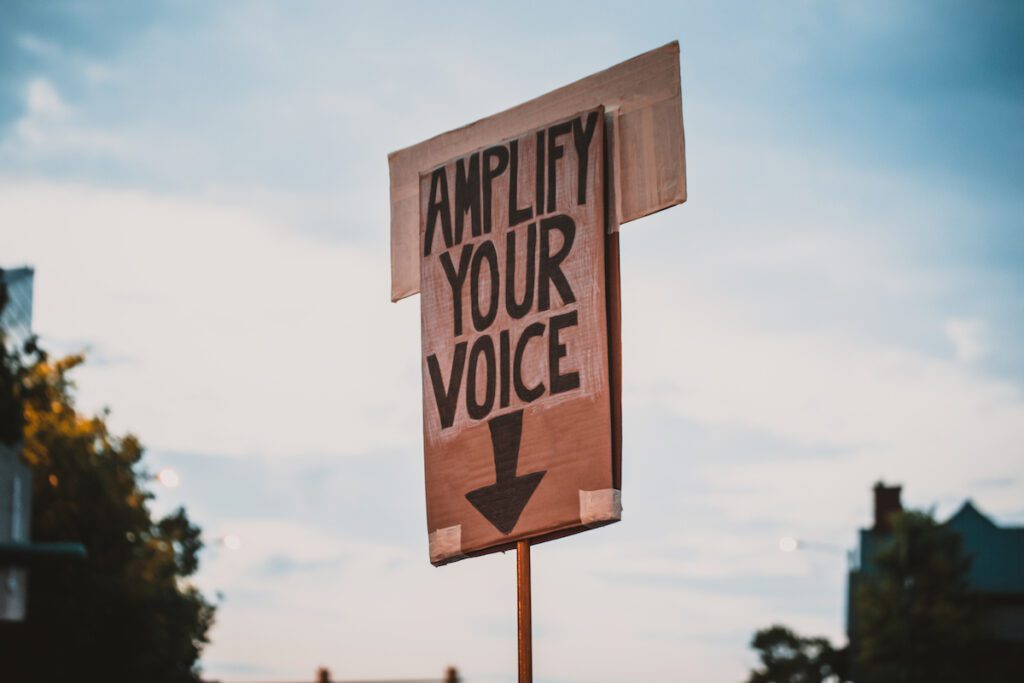
Writing in the third person can be a challenging perspective for many writers, as it requires a careful balance between maintaining your own voice and staying true to the character’s experiences. Here are a few tips to help you write in the third person without losing your voice:
- Establish a clear narrative voice: Establishing a strong narrative voice is an important part of maintaining your own writing style. Think about the type of narrator you want to use and ensure they have a distinct, consistent voice throughout your writing.
- Use strong, descriptive language: One way to add your own voice to a third-person narrative is to use descriptive language that conveys the emotions and experiences of the characters. Instead of simply stating what the character knows or is doing, try to paint a picture of how they feel and what they are thinking.
- Consistency is key: Maintain a consistent writing style and voice throughout your story, no matter what perspective you are using. This will help the reader feel immersed in the story and make it easier for them to connect with the characters.
- Experiment with different perspectives: There are several types of third-person perspectives, and the best one for you will depend on your style and the needs of your story. Don’t be afraid to play with different perspectives and see which works best for your voice.
- Stay true to yourself: Above all, it’s important to stay true to your own voice and not try to imitate someone else’s. Write in a way that feels natural and authentic to you. The more authentic and genuine your writing is, the more engaging it will be for your reader.
Common Mistakes to Avoid When Using Third-Person
Third-person point-of-view writing can be tricky, especially for novice authors. To help make the process easier, here are some common mistakes to avoid.
- Overusing pronouns: When writing in the third person, use character names to create a more engaging narrative. While it can be tempting always reach for pronouns like “he,” “she,” and “they” to refer to characters, this can lead to a narrative that feels distant and impersonal. Using character names instead of pronouns, readers will have an easier time following the story and connecting with the characters.
- Perspective Switching or “Head Hopping.” When the narrative shifts from one character’s point of view to another’s without warning, it’s confusing as it can make it difficult for them to follow the story and understand whose thoughts and actions are being depicted at any given moment. It’s generally best to stick to a consistent perspective within a scene or section of text and to clearly indicate any changes in perspective.
- Failing to establish a clear point of view and consistent voice: Establishing a clear point of view and consistent voice creates a cohesive narrative for the reader. A clear point of view will help the reader understand whose thoughts and feelings are being expressed throughout the story. A consistent voice also prevents the narrative from feeling disjointed and confusing.
- Avoid cliches when describing characters and their actions. Instead of relying on tired, overused phrases, try to find fresh and unique ways to describe your characters and their actions. This will create a more exciting and engaging narrative and will keep the reader interested in the story.
Writing in the third person can be a powerful tool for creating distance between the narrator and the story’s events, allowing for a more objective perspective and exploration of different perspectives to create unique and engaging stories. It can also be used to bring to life a character’s inner thoughts or ideas in a vivid and relatable way.
Take the time to carefully consider what perspective will best serve your story and audience. As you explore writing in this POV, don’t be afraid to experiment with different perspectives and find the one that works best for you and your writing style. Continue practicing and refining your skills with third-person writing and make it another arrow in your quiver to become a more confident and proficient writer. So, keep learning and have fun with it!

Contributing Writer
Molly Rittenhouse
Molly has a passion for writing and helping others improve their writing skills. She is a strong advocate for clear and concise writing, and she enjoys helping others find their voice and improve their writing. When she’s not busy writing, Molly enjoys spending time with her family and friends, exploring new places, and reading good books.
Related Posts

How to Write an Effective Expository Essay

50 Character Development Writing Prompts

The Art of Editing: A Guide for Writers
What Is Third-Person Point of View in Writing? Definition & Examples
The perspective from which a story is told is known as its point of view, showcasing the narrator's position and connection to the narrative. Commonly abbreviated as POV, it determines how near or far, and potentially biased, the narrator is.
In narratives using a third-person point of view, the storyteller addresses characters by their names and employs third-person pronouns. This creates a feeling for the readers as if they are observers of the protagonist and other characters, equipped with varying degrees of insight. We'll explore how to differentiate third-person point of view from other viewpoints, its various forms, and ways to effectively incorporate it into your storytelling!
What is the third-person point of view?
In third-person point of view, the narrator is external to the story and doesn't directly address the reader. They depict characters' actions using names and third-person pronouns like "he" or "she."
“Ella cursed herself under her breath. With planning, her current situation could be so much better, or wouldn’t even exist. But once more, she hadn’t trusted her gut feelings. “When will I ever learn,” she muttered to herself.”
When employing the third-person point of view, a writer can closely follow a main character, switch between characters, or provide an overarching viewpoint. An omniscient narrator knows every character's thoughts; third-person limited centers on one character, and third-person objective narrates events without internal insights. The third-person perspective can vary in its focus, and a writer can adjust its proximity or bias. It's widely used in fiction but is also suitable for non-fiction.
Third person compared to other points of view
Third-person point of view is distinct from other narrative styles due to its unique pronoun use. While third-person POV uses the third-person pronouns "he/she," first and second person deploy "I" and "you," respectively. Here's a brief breakdown:
First-person point of view: The narrator is a character within the story, often the protagonist, and uses "I" to describe events from that character's point of view. They typically convey their own opinions, emotions, and knowledge, although exceptions exist. First-person point of view can be both limited and biased, sometimes shifting between multiple characters. The Great Gatsby by F. Scott Fitzgerald is a notable example, with Nick Carraway narrating while the story revolves around Jay Gatsby and Daisy.
Second-person point of view: This unique style features a detached narrator addressing a character, usually the protagonist, using "you." It immerses readers by making them feel they're in the protagonist's shoes. The narrator can possess omniscient or limited knowledge. This POV is rare and results in an ambiguous protagonist characterization.
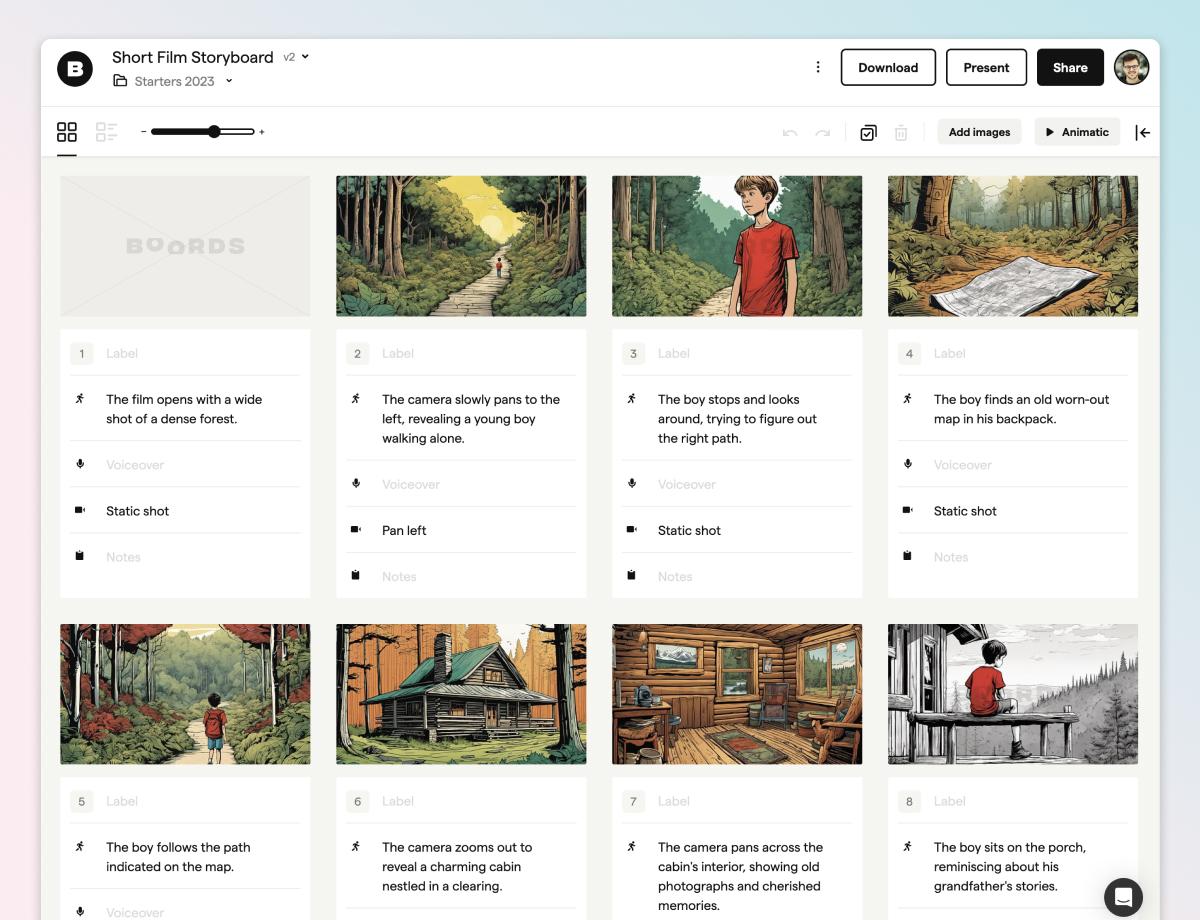
The Shortcut to Effective Storyboards.
Boords is an easy-to-use storyboarding tool to plan creative projects.
Which types of third-person perspectives exist?
The third-person point of view offers the freedom to either center on one character or focus on multiple. This viewpoint can be tailored to craft either an omniscient or limited narrator. The chosen type of third-person POV determines the narrator's proximity to the story. Let's delve into the different types of third-person points of view.
Third-person limited
Often referred to as "close third," the third-person limited point of view can be likened to a video game 'camera' that follows a character from behind or above. Here, the narration zeroes in on one character, potentially sticking with them throughout the narrative or shifting between different characters for various sections or chapters.
The "limited" aspect means the story is channeled through the current character, revealing only their experiences, actions, and thoughts. As a writer, you can delve deep into this character's emotions and inner workings. However, the character remains unaware of other characters' thoughts.
This third-person perspective, abbreviated as third-person limited, is effective for building suspense. Since readers and characters uncover details simultaneously, it's apt for genres like thrillers, mysteries, and crime dramas. If the narrative jumps between characters in distinct settings, it can depict simultaneous events across a vast (fictional) landscape.
While the narrator knows every facet of the story, they restrict their lens to one character at a time. This "limited omniscient" point of view enables a narrative where the broader story unfolds in the reader's mind, even if no character possesses the complete picture.
If the narrative imparts information unknown to the central third-person character, it feels as if the narrator is directly engaging the reader, creating a unique bond. This technique can break the fourth wall or introduce meta-fiction elements. However, it's essential to establish this narrative device early on. Introducing it abruptly can jar readers, potentially disrupting their engagement.
Third person omniscient
The term "omniscient" denotes complete knowledge. In the third-person omniscient point of view, the narrator has comprehensive insight into all characters, sharing this knowledge with the reader. They can seamlessly transition between characters, unveiling any character's innermost thoughts and emotions. This ability can be leveraged to build tension, such as by revealing underlying motives in a character conflict.
While the omniscient narrator knows all, they aren't necessarily impartial. They might show favoritism, perhaps by giving more narrative weight to the protagonist. The third-person omniscient point of view may also interject their personal beliefs, praising or critiquing characters and their actions. Due to this expansive perspective, third-person omniscient point of view narrators often directly engage readers, more so than their third-person limited counterparts.
Third person objective
In the third-person objective point of view, the narrator remains entirely neutral and detached. Unlike other third-person viewpoints, this narrator neither delves into a character's mind nor accesses their emotions and motivations. Instead, they relay events, actions, and dialogues as an unbiased observer, akin to a camera capturing scenes without commentary.
The objective point of view prioritizes factuality and observation. This absence of the narrator's voice, opinions, or judgements lends a voyeuristic feel to the narrative. Readers witness events unfold and draw their own inferences, creating an immersive experience. While particularly effective in short stories, this point of view can also be utilized in longer narratives when the story's essence aligns with such a detached narration.
Examples of third-person perspective in literature
Let's delve into a few notable works by renowned authors to better understand the nuances of the various third-person viewpoints.
Third-person limited examples

J.K. Rowling's Harry Potter series of novels use the third-person limited point of view. While the narrator remains outside the story, they closely follow Harry Potter, the central character and budding wizard. Through this point of view, readers gain insight into Harry's thoughts and emotions, but the omniscient narrator also provides glimpses into events outside of Harry's knowledge:
“A breeze ruffled the neat hedges of Privet Drive, which lay silent and tidy under the inky sky, the very last place you would expect astonishing things to happen. Harry Potter rolled over inside his blankets without waking up. One small hand closed on the letter beside him and he slept on, not knowing he was special, not knowing he was famous, not knowing he would be woken in a few hours time by Mrs. Dursley's scream as she opened the front door to put out the milk bottles, nor that he would spend the next few weeks being prodded and pinched by his cousin Dudley... He couldn't know that at this very moment, people meeting in secret all over the country were holding up their glasses and saying in hushed voices: “To Harry Potter - the boy who lived!””
In a similar vein, George R.R. Martin's Game of Thrones series has a rotating focus. Though the narrative circles through a myriad of characters, it zeroes in on one at a time, confining the point of view to that individual for specific chapters or sections of the story.
More examples of the third-person limited point of view include:
Third-person omniscient examples
In Anna Karenina by Leo Tolstoy, the third-person omniscient point of view is evident. The following passage provides insight into both characters' minds simultaneously:
“Often and much as they had both heard about the belief that whoever is first to step on the rug will be the head in the family, neither Levin nor Kitty could recall it as they made those few steps. Nor did they hear the loud remarks and disputes that, in the observation of some, he had been the first, or, in the opinion of others, they had stepped on it together.”

Jane Austen's Pride and Prejudice also employs this all-knowing third-person point of view:
“When Jane and Elizabeth were alone, the former, who had been cautious in her praise of Mr. Bingley before, expressed to her sister how very much she admired him. “He is just what a young man ought to be,” said she, “sensible, good-humored, lively; and I never saw such happy manners! So much ease, with such perfect good breeding!” ”
Further examples of third-person omniscient are:
Third-person objective examples
Ernest Hemingway's Hills Like White Elephants serves is a quintessential representation of the third-person objective narrative. The third-person narrator provides a view into the scene without adding any internal thoughts, feelings, or biases, solely presenting observable actions and dialogue:
“"What should we drink?" the girl asked. She had taken off her hat and put it on the table. "It's pretty hot," the man said. "Let's drink beer." "Dos cervezas," the man said into the curtain. "Big ones?" a woman asked from the doorway. "Yes. Two big ones." The woman brought two glasses of beer and two felt pads. She put the felt pads and the beer glasses on the table and looked at the man and the girl. The girl was looking off at the line of hills. They were white in the sun and the country was brown and dry. "They look like white elephants," she said. "I've never seen one," the man drank his beer. "No, you wouldn't have."”
Another narrative employing the third-person objective point of view is John Reed’s The Rise of Pancho Villa . Similarly, Shirley Jackson’s The Lottery gives us a scene through the lens of an unbiased onlooker:
“The people of the village began to gather in the square, between the post office and the bank, around ten o'clock; in some towns, there were so many people that the lottery took two days and had to be started on June 25th. But in this village, where there were only about three hundred people, the whole lottery took less than two hours, so it could begin at ten o'clock in the morning and still be through in time to allow the villagers to get home for noon dinner.”
Why use the third-person point of view in your writing?
Many emerging writers gravitate towards the first-person point of view, finding solace in the intimacy it offers with the protagonist. This approach sometimes feels easier as it merges the narrative and authorial voices seamlessly.
Others are drawn to third-person point of view simply believing that it exudes a more literary tone. However, it's crucial that the story's essence and character dynamics guide your choice of narrative stance. Whichever point of view you adopt, maintain it consistently. Shifting perspectives can disorient readers, pulling them out of the narrative.
Here are some reasons why writers might opt for the third-person point of view:
Get your FREE Filmmaking Storyboard Template Bundle
Plan your film with 10 professionally designed storyboard templates as ready-to-use PDFs.
The term ‘omniscient’ may appear overwhelming. But possessing knowledge doesn't mean disclosing everything. Your narrator needn't divulge every event or penetrate every mind continually. Concentrate on the immediate plot progression and the pivotal characters.
A pitfall inexperienced writers may fall into is “head-hopping”, or abruptly shifting points of view. To create suspense, concentrate on the evolving plot, divulging only essential backstories. Propel the narrative forward!
Always consider the information imperative for readers to grasp the storyline, recognizing that this might diverge from a character's knowledge at specific junctures. Balancing character limitations with the chosen point of view can be tricky, but mastering it ensures a captivating read and a gratifying writing journey.
Related links
More from the blog..., what does a cinematographer do.
Cinematographers play an essential role in film production, dictating the overall look and visual style of a motion picture, television show, music video, or advert.
How to End a Story
You’ve invested weeks (months! years!) of hard work writing your story, and it all comes down to this... The end. The last line. No pressure.
Find Your Perfect Story Structure in Three Acts
If you’ve ever tried to write a story, you know it’s pretty hard. Nailing that plot structure. Crafting believable characters. But, if you’re clued up on the rudiments of classic story structure, it can be easy. Or, at least, a little easier.
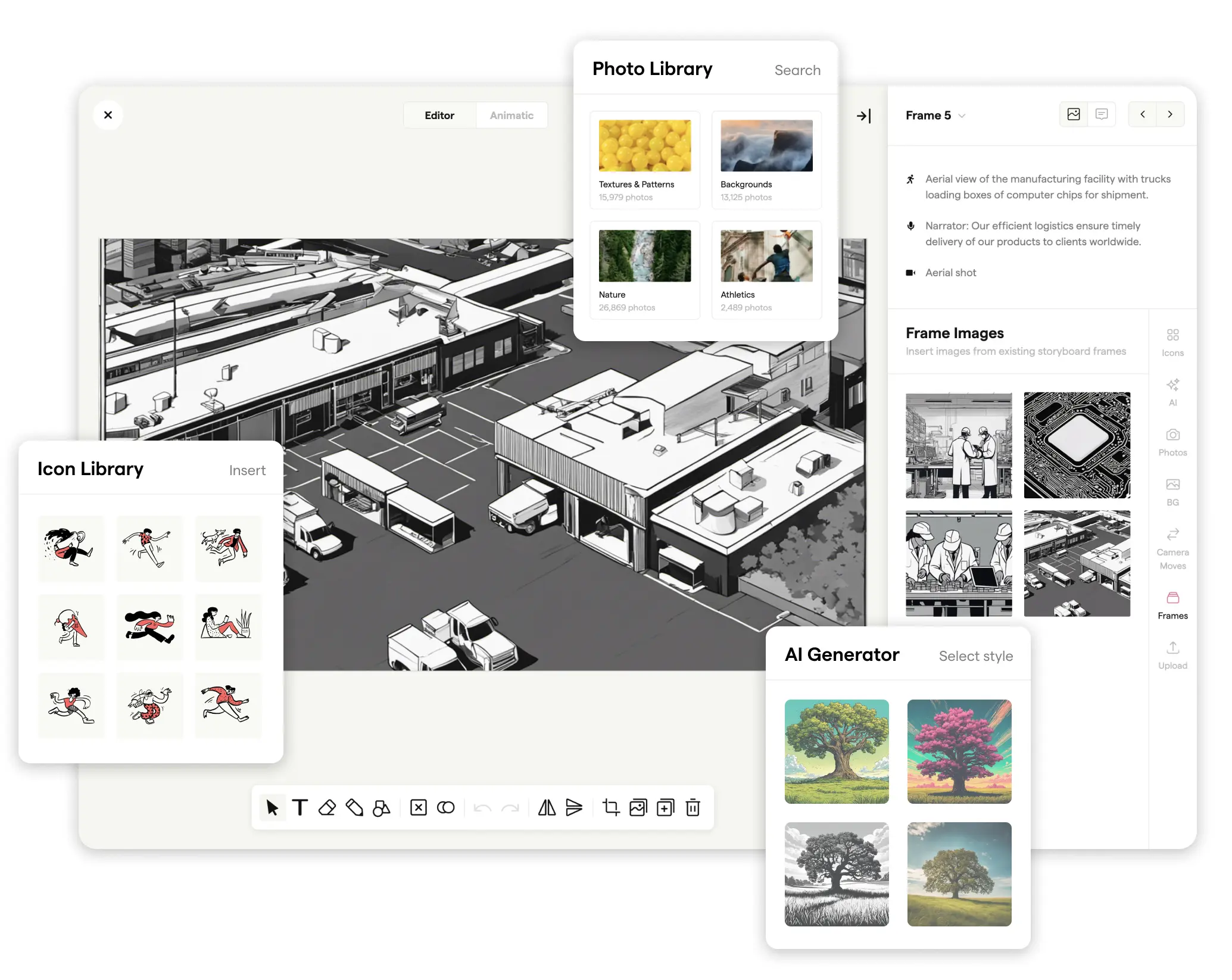
Online storyboarding software
The Shortcut to Effective Storyboards
Boords is the top-rated online storyboarding software that makes planning video projects a joy, not a job.
Point of View in Academic Writing
Point of view is the perspective from which an essay is written. The following chart lists both the personal pronouns and their possessive forms used with these points of view:
| Singular | Plural | |
| I, me (my, mine) | we, us (our, ours) | |
| you (your, yours) | you (your, yours) | |
| they, them (their, theirs) she, her (her, hers) he, him (his) it (its) one (one’s) | they, them (their, theirs) |
When choosing appropriate point of view for academic or formal writing, consider the type and purpose of the assignment.
| When using any of the three points of view, maintaining consistency is vital. Switching between points of view can be confusing for the reader. Choose a suitable perspective and then stay with it. Unclear: The accident happened right in front of so could see who was at fault. |
First Person
First-person point of view is used to write stories/narratives or examples about personal experiences from your own life. Note the following paragraph:
Several people have made a lasting impression on me . I remember one person in particular who was significant to me . Dr. Smith, my high school English teacher, helped my family and me through a difficult time during my junior year. We appreciated her care, kindness, and financial help after the loss of our home in a devastating fire.
Note : Academic writing often requires us to avoid first-person point of view in favor of third-person point of view, which can be more objective and convincing. Often, students will say, “ I think the author is very convincing.” Taking out I makes a stronger statement or claim: “The author is very convincing.”
Second Person
Second-person point of view, which directly addresses the reader, works well for giving advice or explaining how to do something. A process analysis paper would be a good choice for using the second-person point of view, as shown in this paragraph:
In order to prepare microwave popcorn, you will need a microwave and a box of microwave popcorn which you’ve purchased at a grocery store. First of all, you need to remove the popcorn package from the box and take off the plastic wrap. Next, open your microwave and place the package in the center with the proper side up. Then set your microwave for the suggested number of minutes as stated on the box. Finally, when the popcorn is popped, you’re ready for a great treat.
Note : Academic writing generally avoids second-person point of view in favor of third-person point of view. Second person can be too casual for formal writing, and it can also alienate the reader if the reader does not identify with the idea.
Replacing You
In academic writing, sometimes "you" needs to be replaced with nouns or proper nouns to create more formality or to clarify the idea. Here are some examples:
| Quality of education decreases when allow overcrowded classrooms. (Are you, the reader, allowing the conditions?) | Quality of education decreases when allow overcrowded classrooms. (Identifies who is doing what.) |
| On Saturday afternoons, usually have to stand in long lines to buy groceries. | Saturday afternoon usually have to stand in long lines to buy groceries. (Identifies who is doing what.) |
| In many states, have prisons with few rehabilitation programs. (Do you, the reader, have prisons?) | In many states, have few rehabilitation programs. (Identifies the actual subject of the sentence.) |
Third Person
Third-person point of view identifies people by proper noun (a given name such as Shema Ahemed) or noun (such as teachers, students, players, or doctors ) and uses the pronouns they, she, and he . Third person also includes the use of one, everyone, and anyone. Most formal, academic writing uses the third person. Note the use of various third-person nouns and pronouns in the following:
The bosses at the company have decided that employees need a day of in-house training. Times have been scheduled for everyone . Several senior employees will be required to make five-minute presentations. One is not eager to speak in front of others since he’s very shy. Another one , however, is anxious to relate their expertise. The variation in routine should provide an interesting day for all people concerned.
Third Person Pronouns: Gender-Fair Use of Language and Singular “They”
In the past, if you wanted to refer to one unnamed person, you used the masculine pronoun: If a person is strong, he will stand up for himself . Today, you should avoid the automatic use of the masculine pronoun because it is considered sexist language.
Also avoid perpetuating gender stereotypes by assigning a particular gendered pronoun: A doctor should listen to his patients. A nurse should listen to her patients . These examples make assumptions that doctors are men and nurses are women, which is a sexist stereotype.
Instead, use the pronouns they or them to refer to a person whose gender is undisclosed or irrelevant to the context of the usage: If a person is strong, they will stand up for themselves when they believe in something.
- Link to facebook
- Link to linkedin
- Link to twitter
- Link to youtube
- Writing Tips
What’s a Third-Person Narrator?

5-minute read
- 4th February 2022
Most fiction is written in the third person, which means the narrator tells the story from a perspective that’s outside of the events described.
This isn’t the case with first-person narrators. In this case, a character tells the story from their viewpoint and uses the pronoun “I,” while a second-person narrator speaks directly to the reader and uses the pronoun “you.”
Why is Third-Person Narration So Popular?
Open any novel and you’ll probably notice that it uses a third-person narrator. Authors often prefer this form of writing because it’s flexible. Usually, a third-person narrator is a voice that doesn’t belong to anyone, rather than a character in the story. This lets the author show as much of the characters’ actions and thoughts to the reader as they want.
Omniscient and Limited Third-Person Narratives
There are two types of third-person narrators: omniscient and limited . Omniscient narrators know everything about every character in the story. In this example from The Lion, The Witch, and The Wardrobe by C. S. Lewis, the omniscient narrator tells the reader what Lucy and Edmund are thinking and feeling:
. . . he was so odd-looking that Lucy . . . was a little afraid of him, and Edmund . . . wanted to laugh . . .
The omniscient narrative style conveys an objective viewpoint. The reader can trust that the information presented is true because the narrator is “all knowing.”
When authors use a limited point of view, they only show what one or more particular characters know. In The Little House series by Laura Ingalls Wilder, for example, the author uses a third-person narrator but only tells stories from the point of view of the main character, Laura.
A limited point of view is more subjective because the character that the narrator focuses on doesn’t know what the other characters are thinking and doesn’t always see what they’re doing. Therefore, the narrator can only offer their interpretation of what they see and hear.
Common Mistakes in a Third-Person Narrative
When writing in the third person, you should avoid these pitfalls:
● A boring narrative voice: When you write as an omniscient narrator, you must make an extra effort to ensure that readers identify with your characters and are drawn into the story. Since the narrator isn’t directly involved with the characters and the action of the story, the reader may feel detached unless the voice telling the story is distinctive and interesting.
Find this useful?
Subscribe to our newsletter and get writing tips from our editors straight to your inbox.
● Head hopping: A limited narrative style doesn’t have to be limited to a single character’s perspective. But if you jump back and forth between the thoughts of different characters too frequently, it can be confusing for readers. One approach is to introduce a new perspective with each chapter, as Jodi Piccoult does in her novel House Rules . If your narrator is omniscient, you can reveal each of your characters’ inner thoughts. However, when you describe a character’s feelings, be careful not to slip into their voice (rather than the narrator’s).
● Revealing too much information: An omniscient narrator knows everything, but that doesn’t mean they should tell the reader everything. One element of good storytelling is to reveal enough to keep the reader engaged, but not so much that they have no questions left.
Can a Third-Person Narrator be Unreliable?
Absolutely! However, this is much rarer than a first-person narrative and must be attempted very carefully. In most cases, this would involve a limited third-person narrative style that blurs the line between the character and narrator, known as third-person deep . Consider the following sentence:
Wherever he turned he could feel eyes watching him . Of course—it was all a trap! This whole situation had been set up by his parents, and teachers no doubt, to catch him in the act. Jack felt a bead of sweat drip down his cheek.
In this example, Jack’s paranoid thoughts are bleeding into the third-person narrative. It’s an effective way to bring the reader closer to the inner world of the character whilst still maintaining the flexibility of third-person narration.
How Does a Third-Person Narrative Affect the Reader?
Third-Person narrative can expose readers to the perspectives of multiple characters, which can affect how the reader understands the “truth” of the events unfolding. It also allows the writer to provide the reader with key information that might not be known to the main character, which can excite or frustrate the reader if the character makes decisions you know will lead to success or disaster.
Summary: What’s Third-Person Narration?
Writers use third-person narration when they tell a story from the perspective of someone who has nothing to do with the events. This invisible narrator is often omniscient, meaning they know what’s going on in each character’s mind. But it may also be that the point of view is limited to one or more characters.
When writing in the third person, it’s important to establish and stick to the boundaries of what your narrator can see. If you suddenly jump into the head of a character whose thoughts were previously unknown, you risk confusing your readers and spoiling their enjoyment of your writing.
Our eagle-eyed team of proofreaders is experienced in checking all kinds of texts. Whether you’re working on a novel or a short story, we can help you polish your writing. Our editing service also includes pointing out inconsistencies when you narrate in the third person. Why not try us out now by sending a 500-word sample of your writing to proofread for free?
Share this article:
Post A New Comment
Got content that needs a quick turnaround? Let us polish your work. Explore our editorial business services.
Free email newsletter template.
Promoting a brand means sharing valuable insights to connect more deeply with your audience, and...
6-minute read
How to Write a Nonprofit Grant Proposal
If you’re seeking funding to support your charitable endeavors as a nonprofit organization, you’ll need...
9-minute read
How to Use Infographics to Boost Your Presentation
Is your content getting noticed? Capturing and maintaining an audience’s attention is a challenge when...
8-minute read
Why Interactive PDFs Are Better for Engagement
Are you looking to enhance engagement and captivate your audience through your professional documents? Interactive...
7-minute read
Seven Key Strategies for Voice Search Optimization
Voice search optimization is rapidly shaping the digital landscape, requiring content professionals to adapt their...
4-minute read
Five Creative Ways to Showcase Your Digital Portfolio
Are you a creative freelancer looking to make a lasting impression on potential clients or...

Make sure your writing is the best it can be with our expert English proofreading and editing.

COMMENTS
Third-person writing is a style of writing that involves using pronouns such as "he," "she," "it," "they," or "one" to refer to individuals or objects instead of using first- or second-person pronouns like "I," "me," "we," "us," "you," or "your.". Third-person language is commonly used in academic ...
In literature, third-person point of view follows multiple characters and narrative arcs, zooming in and out of a story the way a camera does in a movie. A third-person narrator can be all-knowing (aware of every character's thoughts and feelings) or limited (focused on a single character, or aware only what certain characters say and do).
Writing in Third Person - Examples. | Candace Osmond. | Grammar. The third-person narrative is often employed in narrative writing because it zooms in and out of character perspectives to describe actions, feelings, emotions, and thoughts. If you're unsure how to use the 3rd person perspective in writing, here are some tips and examples.
5.Coach yourself out of using first-person pronouns. If you've only ever written in the first or second person, this is easier said than done. If you find yourself writing in the first person when writing your next paper, go back and alter it to a third-person perspective. 6.Be as specific as possible.
Describe a character's eyes and expressions to reveal character development, tension, and plot-building. 8. Write with authority. Create an authoritative, trustworthy narrator. Writing from third-person stations the narrator above the action, creating a bird's eye view of the story.
1. Third Person Objective Point of View. The third person objective POV is a way to tell your story by giving the reader all the details within the scenes without including what is going on in the characters' minds. To write in the third person objective POV, you will need to create an unbiased narrator who doesn't tell the reader the ...
Third Person Point of View: The 'He Said, She Said' Narrative Style. Third person point of view is narrative style in which the narrator refers to all characters using the pronouns he, she, or they. An example of a sentence written in third person would be: She sat in the café waiting for her food to arrive.
Third Person Omniscient. The third person omniscient point of view frequently appears in fiction writing. With this style, an all-knowing narrator has the ability to get inside any character's head. That's why an omniscient point of view can be thought of as "head-hopping.". The narrator has knowledge of everything.
The first-person POV uses the pronouns I, me, mine, we, us, our, and more. The third-person POV calls for the author to stay in the narrator character's voice while staying consistent with the pronouns he, she, it or they. 5) Choose the best type of third-person POV for your story and remain consistent.
6 tips for writing in third-person. 1. Understand your voice won't always shine in your essays. Every single piece of writing tends to have a voice or point of view as if you're speaking to the reader directly. However, that can't always happen in academic writing as it's objective compared to a novel, for example.
Tip 1: Use third-person determiners and pronouns. In grammar, determiners introduce and modify nouns. They're used to specify what a noun refers to (like " my laptop") or the quantity of it (like " many sandwiches"). Meanwhile, pronouns are substitutes for nouns, referring to people, places, or things. For example, "Caroline [noun ...
Use third person for all academic writing. For formal writing, such as research and argumentative papers, use the third person. Third person makes writing more objective and less personal. For academic and professional writing, this sense of objectivity allows the writer to seem less biased and, therefore, more credible.
In first person point of view the narrator is a character in the story telling it from their perspective. In third person point of view the narrator is not part of the story and the characters never acknowledge the narrator's presence. Less common than first and third is second person point of view. In second person point of view the reader is ...
Third-person multiple PoV is a narrative point of view in which the narrator follows several different characters using the pronouns "she," "he," or "they." The story alternates between various characters such as two love interests, a protagonist and antagonist, or a group of friends. Unlike omniscient PoV, the narrator can only see ...
1. Show more perspectives. With third person, you can write from the close perspective of a diverse range of characters and include a variety of settings, expanding the story to an epic scope. It ...
The third person point of view is used to keep distance between the writer and reader. As a result, characters serve as a buffer so that the focus remains on the narrative. We're going to break down the third person point of view, or third person POV, with examples from The Lord of the Rings and Uncharted, but first, let's review some ...
In the broad world of prose fiction writing, you must make a key decision that will affect every aspect of your novel, novella, or short story: What narrative voice will you use? When narrating fiction, authors traditionally choose between first-person point of view and third-person point of view (second-person point of view is less common ...
Key Takeaways. Third-person pronouns such as 'he', 'she', 'it', 'they', and 'them' refer to people outside the scope of the conversation. The third-person narrative provides impartiality to the text. A third-person perspective is used to tell a story from one character's point of view or an all-knowing point of view.
Interactive example of a narrative essay. An example of a short narrative essay, responding to the prompt "Write about an experience where you learned something about yourself," is shown below. Hover over different parts of the text to see how the structure works. Narrative essay example.
Some of the benefits and reasons for choosing to write in the third person include the following: Objectivity: Writing in the third-person point of view allows the writer to maintain an objective, unbiased tone if needed. The events can be presented as they happened, without the filter of opinion or emotion. Distance: Third-person POV creates a ...
A Wizard of Earthsea by Ursula Le Guin; Third-person objective examples. Ernest Hemingway's Hills Like White Elephants serves is a quintessential representation of the third-person objective narrative. The third-person narrator provides a view into the scene without adding any internal thoughts, feelings, or biases, solely presenting observable actions and dialogue:
Third Person. Third-person point of view identifies people by proper noun (a given name such as Shema Ahemed) or noun (such as teachers, students, players, or doctors) and uses the pronouns they, she, and he.Third person also includes the use of one, everyone, and anyone. Most formal, academic writing uses the third person. Note the use of various third-person nouns and pronouns in the following:
Open any novel and you'll probably notice that it uses a third-person narrator. Authors often prefer this form of writing because it's flexible. Usually, a third-person narrator is a voice that doesn't belong to anyone, rather than a character in the story. This lets the author show as much of the characters' actions and thoughts to the ...